Flextronics Sales and NC800-GW223R1 Motorola Cellular Gateway User Manual MOTRGW200TN1165 A102 12
Flextronics Sales & Marketing (A-P) Ltd. Motorola Cellular Gateway MOTRGW200TN1165 A102 12
Contents
User manual pt 4
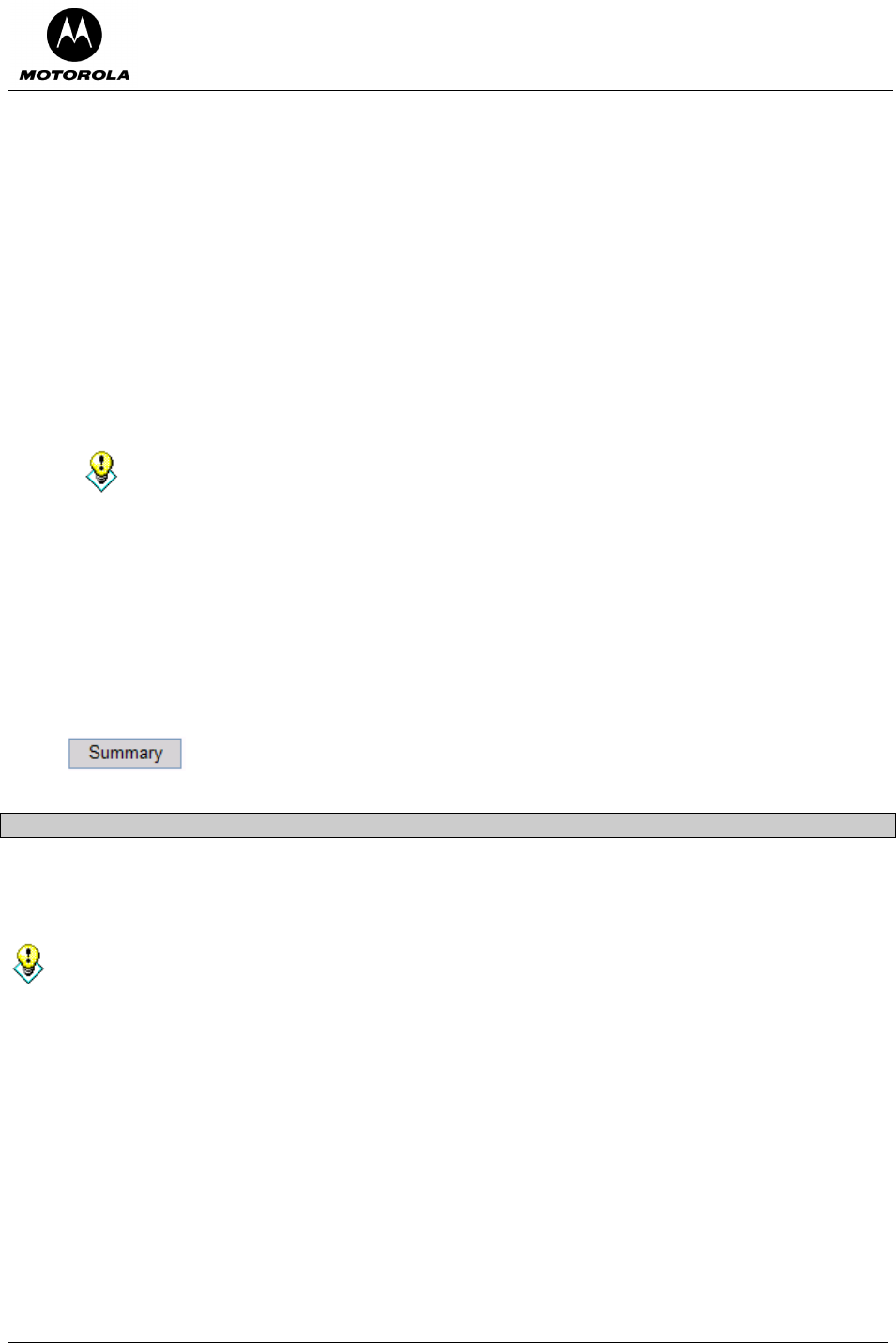
Motorola Cellular Gateway NC800 User Guide Version 2.0 Page 78 of 110
• WLAN SSID – The SSID being used by the wireless interface.
• WLAN Channel – The current wireless LAN channel being used.
• WLAN MAC – The MAC address of the WLAN interface.
• WAN Link Status – The state of the WAN link. If there is a WAN connection then this will show
"Connected".
• WAN Link Idle Time – The time that the WAN link was idle i.e. total time PPP connection was idle.
• WAN Link Up Time – The time that the WAN link was in a connected state i.e. total time PPP
connection is established.
• WAN Link Signal Strength – The last read signal strength for the WAN (CDMA) module obtained
when the WAN module was not in data mode.
• WAN Module ESN – The ESN of the WAN module.
• WAN Firmware Version – The version of the WAN firmware currently running on the gateway.
• WAN IP Address – The IP address of the WAN interface.
• WAN Default Gateway – The IP address of the default Gateway for the current WAN connection.
• WAN Subnet Mask – The WAN Subnet Mask.
If WAN IP Settings are statically configured, the WAN IP Address, WAN Default Gateway
and WAN Subnet Mask fields display the values configured on the WAN->IP Settings page.
For dynamic WAN IP settings, the WAN IP Address, WAN Default Gateway and WAN
Subnet Mask fields will only get set once the WAN Link is in the Connected state.
• WAN DNS Server 1 – The first DNS server IP address.
• WAN DNS Server 2 – The second DNS server IP address.
• WAN DNS Server 3 – The third DNS server IP address.
• DHCP Server Status – The status of the DHCP server (Enabled / Disabled).
Special Buttons:
Displays the Summarized status Information.
Administration-> Support Server Registration
This function allows the Motorola Cellular Gateway NC800 to register itself with a remote support server. If an
acknowledgement to the HTTP Post message is not received, the Motorola Cellular Gateway NC800
periodically re-sends the message until the acknowledgement is received.
The support server registration URL will be provided to you by the Cellular Carrier or ISP if it has not
been configured by default on the Motorola Cellular Gateway NC800.
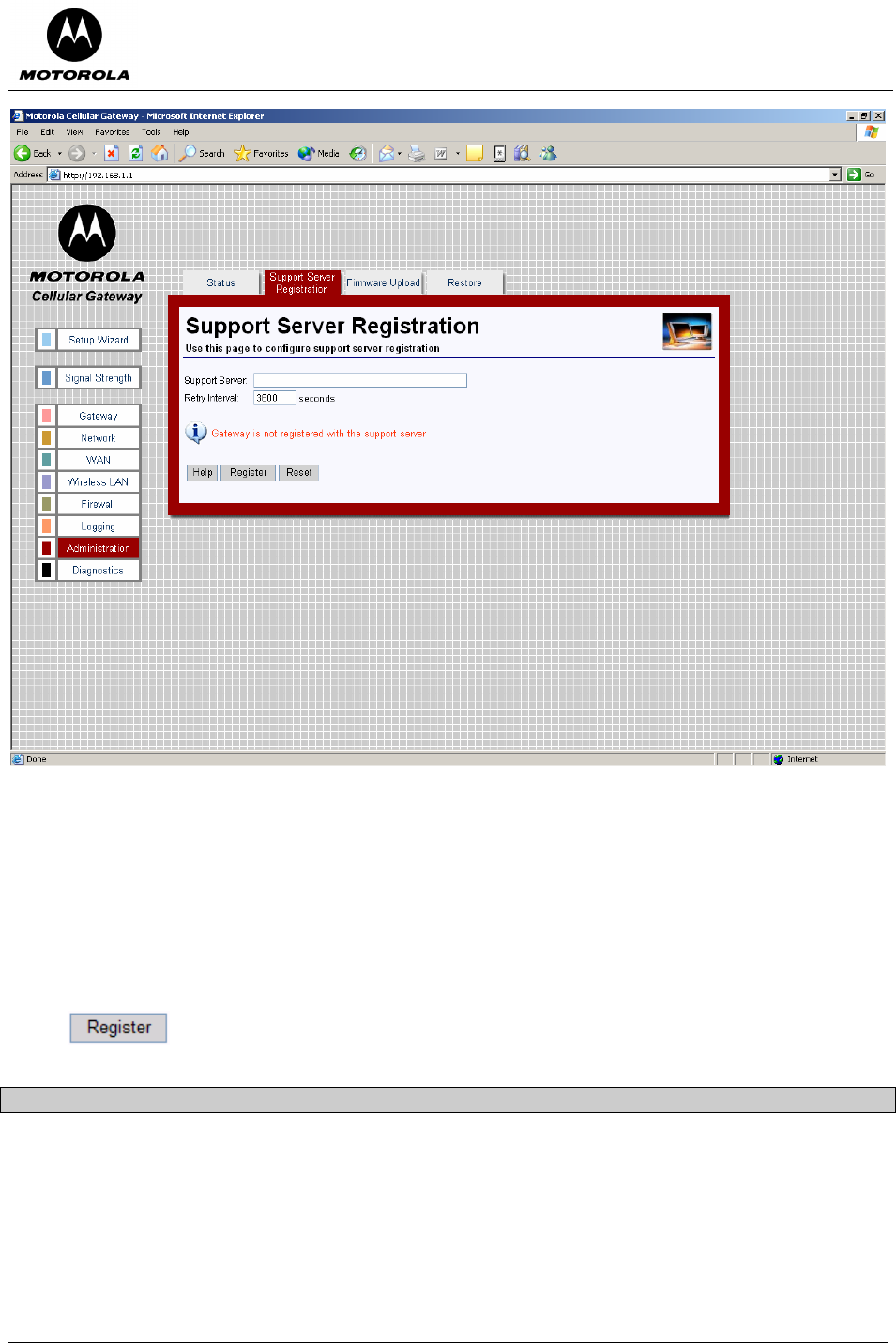
Motorola Cellular Gateway NC800 User Guide Version 2.0 Page 79 of 110
• Support Server – The URL of the support server registration script. You should set this to be:
http://<IP>/Moto3G/gateway_register.asp where <IP> is the IP address of the server that is running the
statistics logging script and Moto3G is the name of the directory on the web server where the script is
stored. Maximum of 4095 characters beginning with the string "http://". The Registration Server can be
located anywhere on the Internet.
• Retry Interval – Period between 60 and 65535 seconds at which the Post message is resent in case of
failure.
Special Buttons:
Initiates the contact with the Support Server
Administration-> Firmware Upload
You have two options to upgrade the firmware of the Motorola Cellular Gateway NC800:
• Use Firmware Upgrade screen in the web-based configuration utility.
• Use a TFTP client.
See Appendix D for more information on using a TFTP client to upgrade the Motorola Cellular Gateway NC800
firmware.
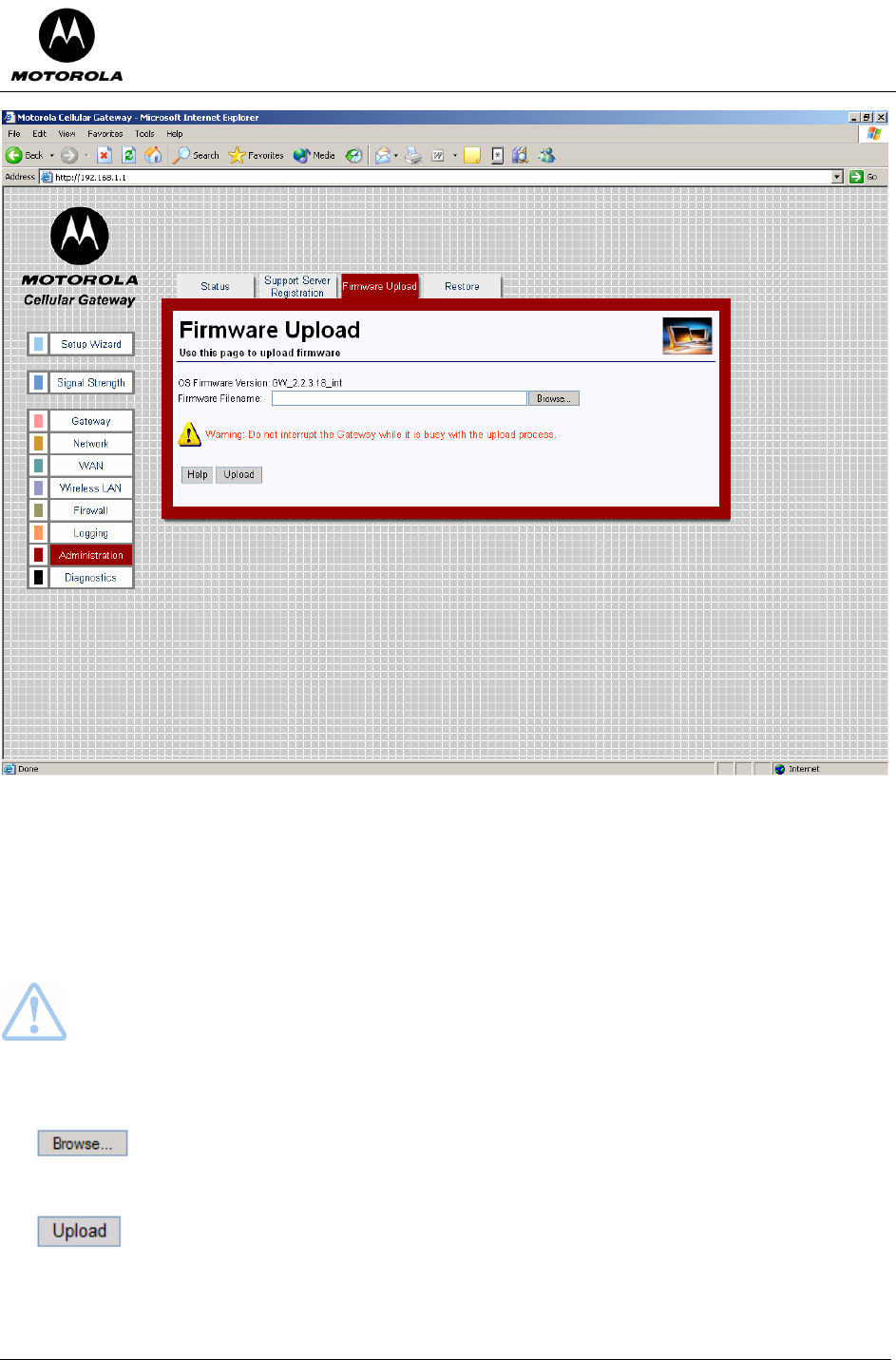
Motorola Cellular Gateway NC800 User Guide Version 2.0 Page 80 of 110
Web-based firmware upload:
• OS Firmware Version – Current version of operating system in the Motorola Cellular Gateway NC800.
• Firmware Filename – URL of the new firmware image file. Click on the "Browse" button to browse to
the image file on your machine. Firmware files are files having a .trx extension – for example linux.trx
is a valid firmware filename. Typically, firmware files are roughly 2.5 MB in size, however, this may differ
for newer versions of the firmware.
Warning: Do NOT interrupt the upload process. Doing so may cause the firmware in the Motorola
Cellular Gateway NC800 to become corrupted. If this happens your only option is to use a TFTP
client to repair the firmware. See Appendix D for more information on using a TFTP client to
upgrade the Motorola Cellular Gateway NC800’s firmware.
Special Buttons:
Allows the user to browse the local computer file system for a file to upload.
Once you have selected a new firmware file to download to the Motorola Cellular Gateway
NC800, click on the Upload button. The upload process takes a few minutes to complete.
The Motorola Cellular Gateway NC800 will let you know when the upload has completed.
After the upload, the Motorola Cellular Gateway NC800 automatically reboots using the new
firmware.
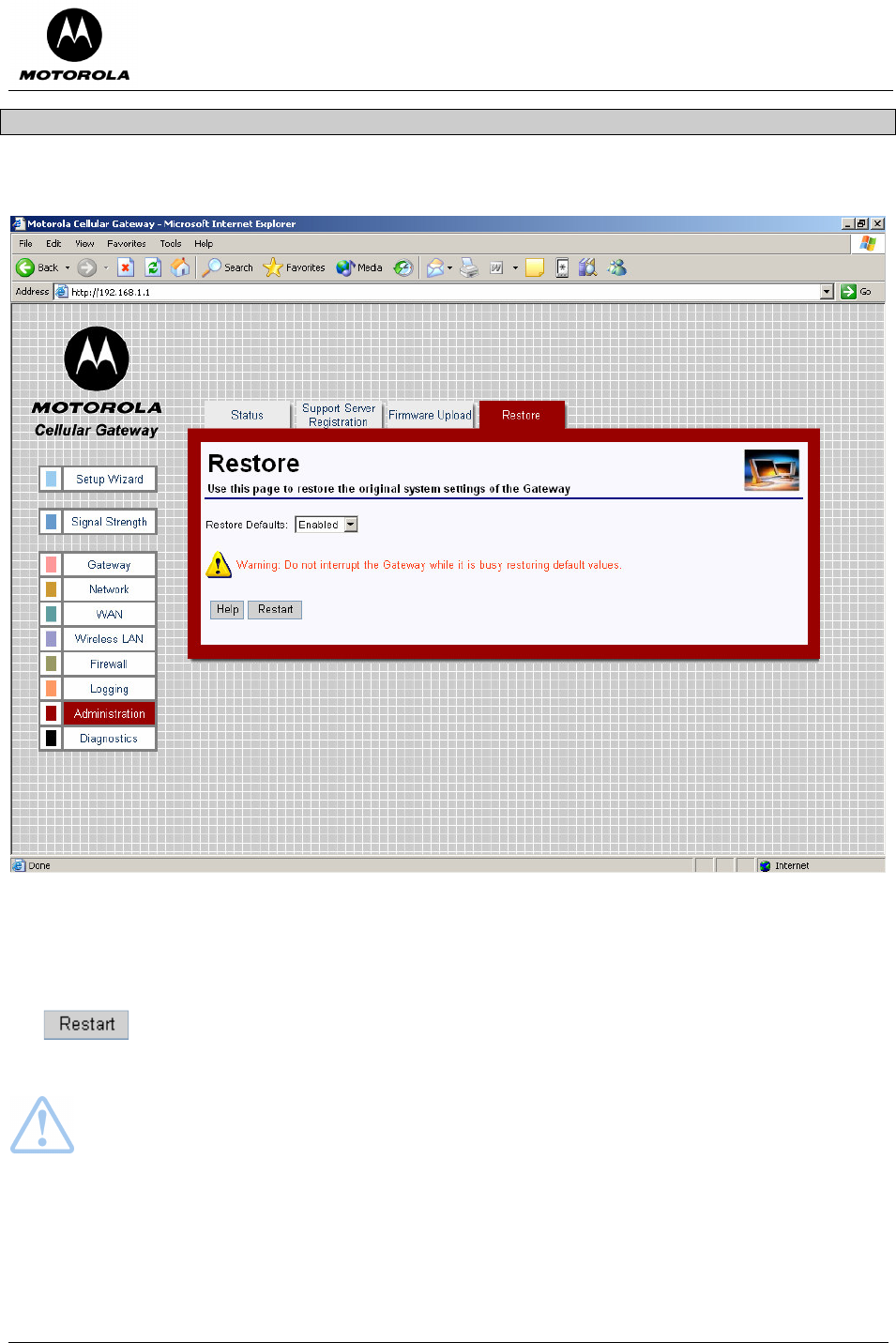
Motorola Cellular Gateway NC800 User Guide Version 2.0 Page 81 of 110
Administration-> Restore
If you want to restore the Motorola Cellular Gateway NC800’s factory default settings you can do this via the
Web Configuration utility.
• Restore Defaults – When Enabled the Motorola Cellular Gateway NC800 will restart with the Default
Settings when the Restart button is pressed.
Special Buttons:
Click on the button to restart the Motorola Cellular Gateway NC800. If the Restore Defaults
parameter is Enabled, the Motorola Cellular Gateway NC800’s defaults are restored. The
process will take approximately 10 seconds to complete.
Warning: Any settings you have saved will be lost if the default settings are restored.
Please note – the Motorola Cellular Gateway NC800’s IP address reverts back to the
default of 192.168.1.1 so you will need to point your browser to that address after the
restore
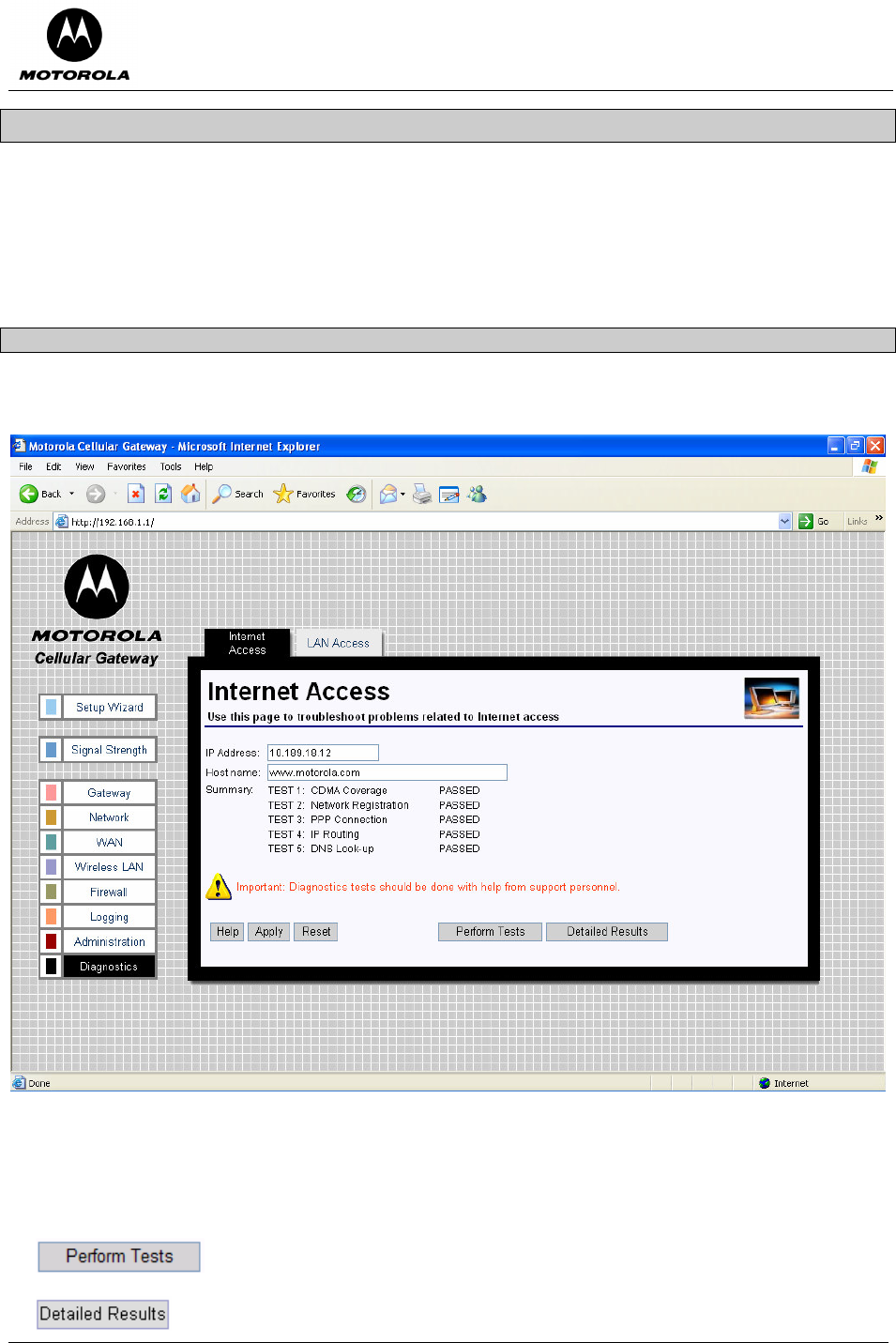
Motorola Cellular Gateway NC800 User Guide Version 2.0 Page 82 of 110
Diagnostics
There are two pages in the Diagnostics category:
Diagnostics-> Internet Access This page is used to troubleshoot problems related to
Internet Access.
Diagnostics-> LAN Access This page is used to troubleshoot problems related to LAN
Access.
Diagnostics-> Internet Access
This page allows the user to debug errors related to CDMA coverage, CDMA network registration and status,
establishment of a PPP connection, IP routing, and DNS lookup.
• IP Address – Sets the IP address to use for the IP routing diagnostics test.
• Host name – The name of the target server that is used to verify the DNS lookup during the diagnostics
test.
Special Buttons:
Let the Motorola Cellular Gateway
NC800 perform the tests
Display the results of the tests
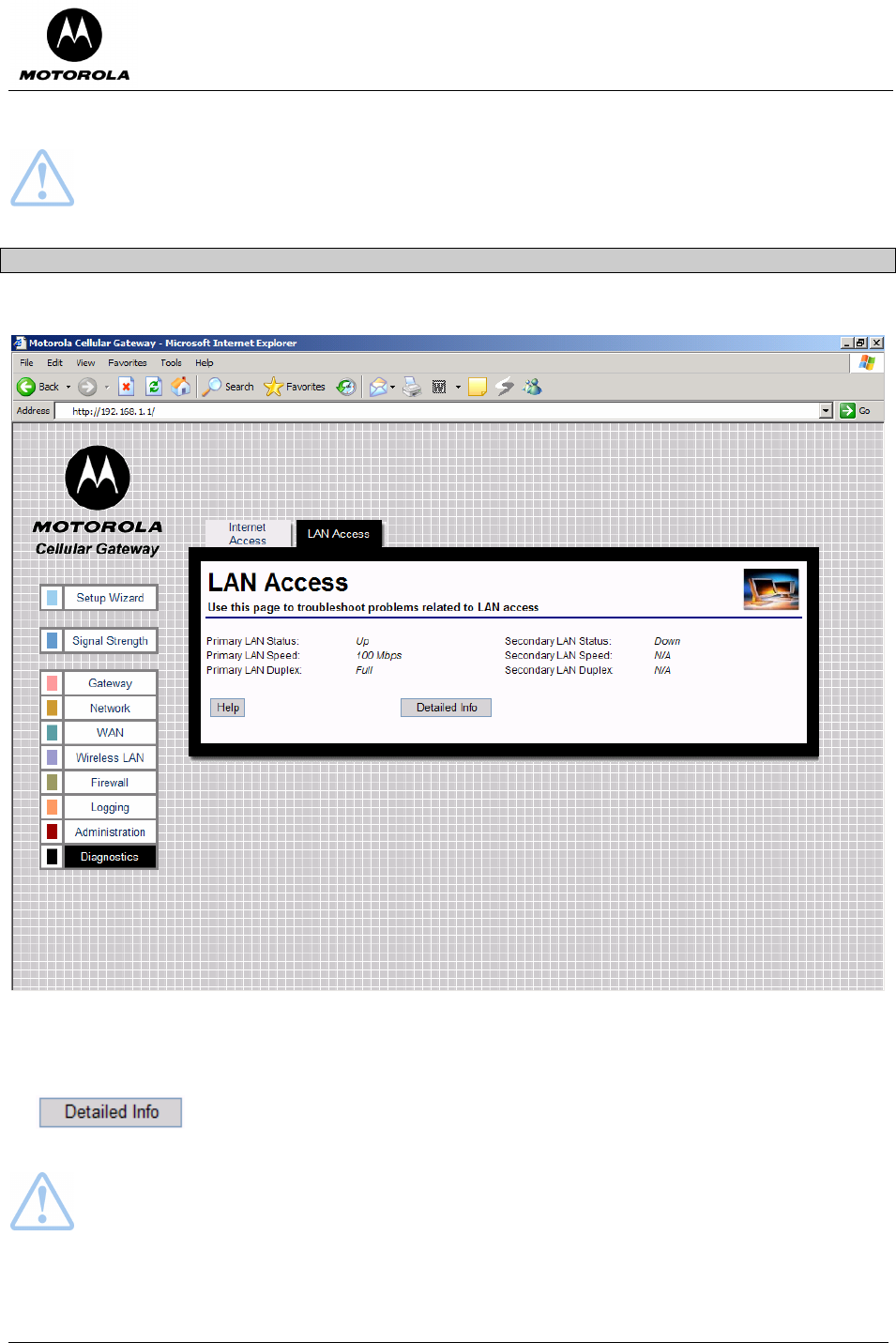
Motorola Cellular Gateway NC800 User Guide Version 2.0 Page 83 of 110
Important: Diagnostics tests should be done with help from support personnel. The detailed
results page is not intended for the home user.
Diagnostics-> LAN Access
This page allows the user to debug errors related to LAN access.
This screen displays the summarized info of the LAN status.
Special Buttons:
Display the detailed information
about the LAN.
Important: Diagnostics tests should be done with help from support personnel. The detailed
information page is not intended for the home user.

Motorola Cellular Gateway NC800 User Guide Version 2.0 Page 84 of 110
Appendix A: Motorola Limited Warranty
Warranty
What Does this Warranty Cover?
Subject to the exclusions contained below, Motorola, Inc. warrants its Cellular Gateway NC800s, Motorola-
branded or certified accessories sold for use with these Products (“Accessories”) and Motorola software
contained on CD-ROMs or other tangible media and sold for use with these Products (“Software”) to be free
from defects in materials and workmanship under normal consumer usage for the period(s) outlined below.
This limited warranty is a consumer's exclusive remedy, and applies as follows to new Motorola Products,
Accessories and Software purchased by consumers, which are accompanied by this written warranty:
Products and Accessories
Products Covered Length of Coverage Products and Accessories as defined above, unless otherwise
provided below.
One (1) year from the date of purchase by the first consumer purchaser of the product unless otherwise
provided for below.
Exclusions
Normal Wear and Tear. Periodic maintenance, repair and replacement of parts due to normal wear and tear
are excluded from coverage.
Abuse & Misuse. Defects or damage that result from: (a) improper operation, storage, misuse or abuse,
accident or neglect, such as physical damage (cracks, scratches, etc.) to the surface of the product resulting
from misuse; (b) contact with liquid, water, rain, extreme humidity or heavy perspiration, sand, dirt or the like,
extreme heat, or food; (c) use of the Products or Accessories for commercial purposes or subjecting the Product
or Accessory to abnormal usage or conditions; or (d) other acts which are not the fault of Motorola, are excluded
from coverage.
Use of Non-Motorola Products and Accessories. Defects or damage that result from the use of Non-
Motorola branded or certified Products, Accessories, Software or other peripheral equipment are excluded from
coverage.
Products and Accessories that are Repaired or Replaced. The balance of the original warranty or for
ninety (90) days from the date returned to the consumer, whichever is longer.
Products Covered Length of Coverage Unauthorized Service or Modification. Defects or damages
resulting from service, testing, adjustment, installation, maintenance, alteration, or modification in any way by
someone other than Motorola, or its authorized service centers, are excluded from coverage.
Altered Products. Products or Accessories with (a) serial numbers or date tags that have been removed,
altered or obliterated; (b) broken seals or that show evidence of tampering; (c) mismatched board serial
numbers; or (d) nonconforming or non-Motorola housings, or parts, are excluded from coverage.
Communication Services. Defects, damages, or the failure of Products, Accessories or Software due to any
communication service or signal you may subscribe to or use with the Products Accessories or Software is
excluded from coverage.
Software Exclusions
Software Embodied in Physical Media. No warranty is made that the software will meet your requirements or
will work in combination with any hardware or software applications provided by third parties, that the operation
of the software products will be uninterrupted or error free, or that all defects in the software products will be
corrected.
Software NOT Embodied in Physical Media. Software that is not embodied in physical media (e.g. software
that is downloaded from the internet), is provided “as is” and without warranty.

Motorola Cellular Gateway NC800 User Guide Version 2.0 Page 85 of 110
Products Covered Length of Coverage Software. Applies only to physical defects in the media that embodies
the copy of the software (e.g. CD-ROM, or floppy disk). Ninety (90) days from the date of purchase.
Who Is Covered?
This warranty extends only to the first consumer purchaser, and is not transferable.
What Will Motorola Do?
Motorola, at its option, will at no charge repair, replace or refund the purchase price of any Products,
Accessories or Software that does not conform to this warranty. We may use functionally equivalent
reconditioned/refurbished/pre-owned or new Products, Accessories or parts. No data, software or applications
added to your Product, Accessory or Software will be reinstalled.
How to Obtain Warranty Service or Other Information
Please review the website and/or phone numbers listed below for the product with which they are used. You will
receive instructions on how to ship the Products, Accessories or Software, at your expense, to a Motorola
Authorized Repair Center. To obtain service, you must include: (a) a copy of your receipt, bill of sale or other
comparable proof of purchase; (b) a written description of the problem; (c) the name of your service provider, if
applicable; (d) the name and location of the installation facility (if applicable) and, most importantly; (e) your
address and telephone number.
www.hellomoto.com
Select “Services”
Latin America:
Centro de Atencion Motorola
Argentina: 0800-666-8676
Chile: 0800-201-442
Columbia: 01-800-700-1504
Mexico: 01-800-021-0000
Peru: 0-800-52-470
Venezuela: 0800-100-4289
Brazil:
Motorola Industrial Ltda.
Rodovia SP-340 - km 128,7 - Bairro Tanquinho
CEP 13820-000 - JaguariŽ na - SP
Central de Relacionamento Motorola
Capitais e Regiões Metropolitanas: 4002-1244
Demais Localidades: 0800-773-1244
North America
Canada: 800-461-4575
US: 800-331-6456
Hong Kong
(852) 2506-3888
China
800-810-5050

Motorola Cellular Gateway NC800 User Guide Version 2.0 Page 86 of 110
For Accessories and Software, please review the website and/or phone numbers listed above for the product
with which they are used. You will receive instructions on how to ship the Products, Accessories or Software, at
your expense, to a Motorola Authorized Repair Center. To obtain service, you must include: (a) a copy of your
receipt, bill of sale or other comparable proof of purchase; (b) a written description of the problem; (c) the name
of your service provider, if applicable; (d) the name and location of the installation facility (if applicable) and,
most importantly; (e) your address and telephone number.
What Other Limitations Are There?
ANY IMPLIED WARRANTIES, INCLUDING WITHOUT LIMITATION THE IMPLIED WARRANTIES OF
MERCHANTABILITY AND FITNESS FOR A PARTICULAR PURPOSE, SHALL BE LIMITED TO THE
DURATION OF THIS LIMITED WARRANTY, OTHERWISE THE REPAIR, REPLACEMENT, OR REFUND AS
PROVIDED UNDER THIS EXPRESS LIMITED WARRANTY IS THE EXCLUSIVE REMEDY OF THE
CONSUMER, AND IS PROVIDED IN LIEU OF ALL OTHER WARRANTIES, EXPRESS OR IMPLIED. IN NO
EVENT SHALL MOTOROLA BE LIABLE, WHETHER IN CONTRACT OR TORT (INCLUDING NEGLIGENCE)
FOR DAMAGES IN EXCESS OF THE PURCHASE PRICE OF THE PRODUCT, ACCESSORY OR
SOFTWARE, OR FOR ANY INDIRECT, INCIDENTAL, SPECIAL OR CONSEQUENTIAL DAMAGES OF ANY
KIND, OR LOSS OF REVENUE OR PROFITS, LOSS OF BUSINESS, LOSS OF INFORMATION OR DATA,
SOFTWARE OR APPLICATIONS OR OTHER FINANCIAL LOSS ARISING OUT OF OR IN CONNECTION
WITH THE ABILITY OR INABILITY TO USE THE PRODUCTS, ACCESSORIES OR SOFTWARE TO THE
FULL EXTENT THESE DAMAGES MAY BE DISCLAIMED BY LAW.
Some states and jurisdictions do not allow the limitation or exclusion of incidental or consequential
damages, or limitation on the length of an implied warranty, so the above limitations or exclusions may
not apply to you. This warranty gives you specific legal rights, and you may also have other rights that
vary from state to state or from one jurisdiction to another.
Laws in the United States and other countries preserve for Motorola certain exclusive rights for copyrighted
Motorola software such as the exclusive rights to reproduce and distribute copies of the Motorola software.
Motorola software may only be copied into, used in, and redistributed with, the Products associated with such
Motorola software. No other use, including without limitation disassembly of such Motorola software or exercise
of the exclusive rights reserved for Motorola, is permitted.
Information from the World Health Organization
IPresent scientific information does not indicate the need for any special precautions for the use of mobile
phones. If you are concerned, you may want to limit your own or your children’s RF exposure by limiting the
length of calls or by using handsfree devices to keep mobile phones away from your head and body.
Source: WHO Fact Sheet 193
Further information: http://www.who.int./peh-emf
Product Registration
Online Product Registration: http://www.motorola.com/warranty
Product registration is an important step toward enjoying your new Motorola product. Registering helps us
facilitate warranty service, and permits us to contact you should your product require an update or other
service. Registration is for U.S. residents only and is not required for warranty coverage. Please retain your
original dated sales receipt for your records. For warranty service of your Motorola Product you will need to
provide a copy of your dated sales receipt to confirm warranty status. Thank you for choosing a Motorola
product.
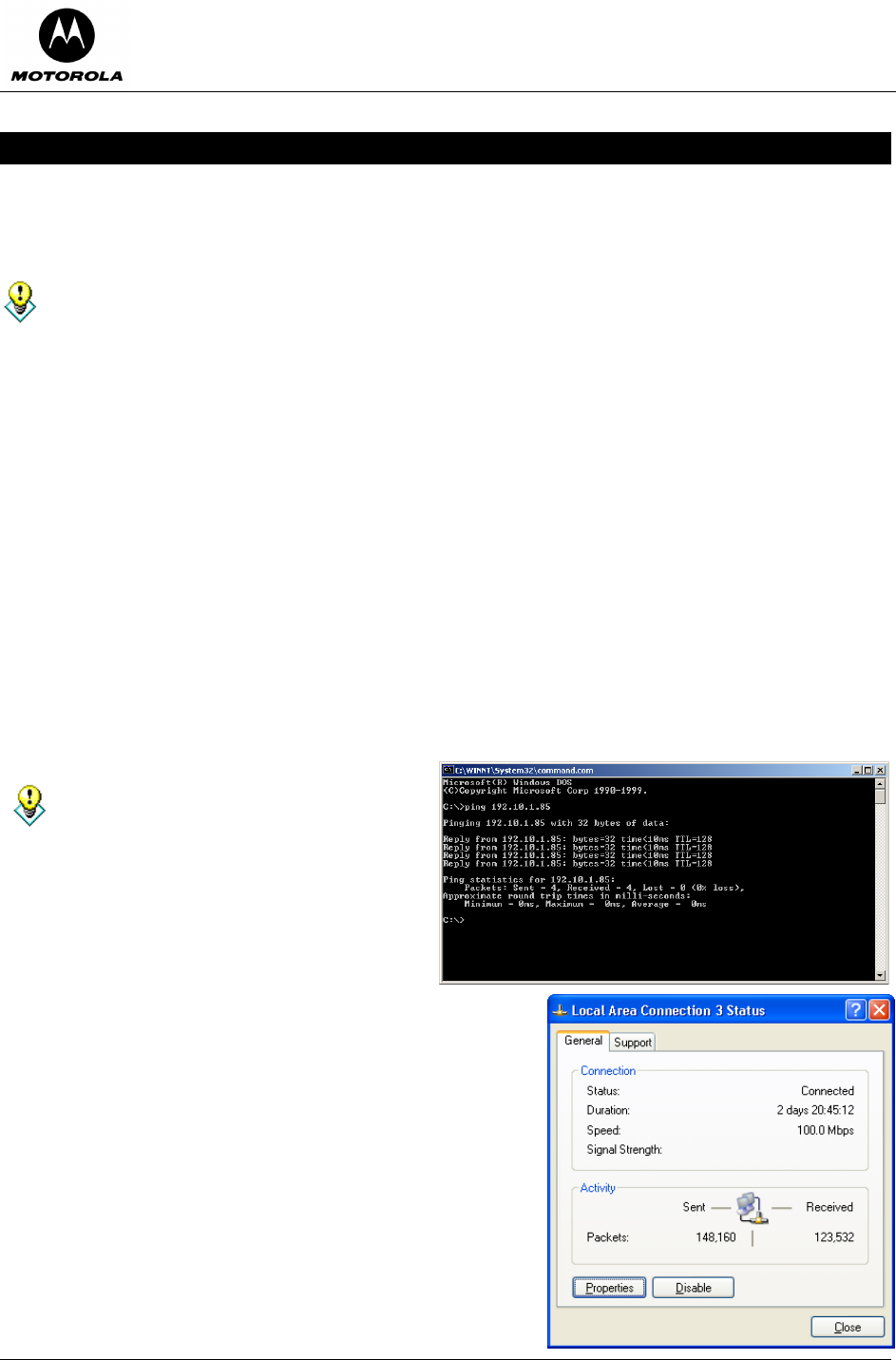
Motorola Cellular Gateway NC800 User Guide Version 2.0 Page 87 of 110
Appendix B: Troubleshooting
This section discusses possible problems and outlines possible solutions.
1. I cannot access the Motorola Cellular Gateway NC800’s web-based Configuration utility.
It is recommended, but not required, that you configure the Motorola Cellular Gateway NC800 via a
computer that is directly connected to the Motorola Cellular Gateway NC800’s LAN interface.
• Check that the Motorola Cellular Gateway NC800 is properly installed and is powered ON.
• Check that there is a network connection between the Motorola Cellular Gateway NC800 and the
computer that is being used to configure the Motorola Cellular Gateway NC800.
o Check that the computer is connected to the Motorola Cellular Gateway NC800, either directly or
via another network path for example via a hub or a switch.
o Check that the computer’s Ethernet adapter is working correctly.
Ensure that the drivers for the network adapters are installed correctly.
Check the status of the network connection. It should say “connected” or indicate the speed
of the connection e.g. 10 Mbps or 100 Mbps.
o Check that the PC’s IP address is in the same range and subnet as that of the Motorola Cellular
Gateway NC800.
o Try to ping the Motorola Cellular Gateway NC800 to make sure that it is responding. Open a
command console window (Go to Start -> Run. Type in cmd (if you are using Windows 98 / ME
type in command). When the console window opens, type in ping 192.168.1.1. If you have
changed the IP address of the Motorola Cellular Gateway NC800 then use that address instead.
The Motorola Cellular Gateway NC800 should respond with four replies.
• Check the Security Level set on the Browser. Depending on the browser, a High Security Level might
prevent Javascripts from being executed on the PC. On the browser configuration, set the Internet
Security to Low and ensure that Javascripting is enabled.
A quick way to check a network
connection is to use the ping
command. Type in ping
xxx.xxx.xxx.xxx where xxx is the IP
Address that you want to test. The
command then sends test packets to
the destination address. If there exists a
network connection to the address, you
should see four replies.
Be sure to use the correct IP address.
2. How do I check that my LAN Ethernet adapter is working
correctly?
• Select Control Panel from My Computer. Go to Network
Connections and double-click on the Ethernet Adapter.
• If your network card is working correctly:
o The Status will be Connected.
o The Sent and Received byte counter will increase as
data is sent and received via the network adapter.

Motorola Cellular Gateway NC800 User Guide Version 2.0 Page 88 of 110
3. I cannot establish a wireless connection to the Motorola Cellular Gateway NC800.
Please consult the user guide of your computer’s WLAN adaptor when configuring any of the
settings discussed below.
• Check that you are using the same SSID and channel number as the Motorola Cellular Gateway
NC800. If either one is not the same then the wireless data packets will be ignored by the Motorola
Cellular Gateway NC800.
• If the Motorola Cellular Gateway NC800 is set to use WEP encryption then ensure that the wireless
adapter on the client is also set accordingly. Make sure the encryption level (i.e. whether a 64-bit or
128-bit key is used) is set to the same level on both the client and the Motorola Cellular Gateway
NC800. Also check that the encryption keys are the same.
4. My wireless LAN connection is being dropped intermittently.
• Please refer to the Installation Considerations section for more information on how to optimally
position wireless network devices.
• Check the antenna orientation on the Motorola Cellular Gateway NC800.
• Check to see if other electronic equipment is not interfering with the wireless data transmissions.
• Use the laptop or workstation’s signal strength indicator to see what the signal strength is at the current
location. It could be that the signal strength is just too low for a reliable connection. In this case you
need to move the wireless adapter closer to the Motorola Cellular Gateway NC800 for increased signal
strength.
5. The network is configured correctly, but the Motorola Cellular Gateway NC800 is not responding
• Check to see if any of the lights (LEDs) on the Motorola Cellular Gateway NC800 are flickering at all.
• If the is no flickering for an extended period of time then you can try to reset the Motorola Cellular
Gateway NC800 by pressing the Reset button at the back of the Motorola Cellular Gateway NC800. Do
not hold the Reset button in, only press it once and release it again. This will reset the Motorola Cellular
Gateway NC800.
6. I do not know the IP address / User name / Password of the Motorola Cellular Gateway NC800
anymore.
In some cases, the IP address / User Name / Password of the Motorola Cellular Gateway NC800 may not be
known anymore, making it impossible to connect to the web-based Configuration Utility.
• After you have tried all other methods of trouble shooting, you can restore the Motorola Cellular
Gateway NC800’s factory default settings.
o Locate the Reset button on the back of the Motorola Cellular Gateway NC800.
o Press the Reset button and hold it down for 10 seconds.
o Release the Reset button.
o The Motorola Cellular Gateway NC800 will reboot and all the settings will be set according to the
factory default settings.
o You will have to redirect any open web browser to the Motorola Cellular Gateway NC800’s default
IP address: 192.168.1.1, using the default user name (admin) and password (admin).
7. When using DHCP on the LAN interface, the IP address that my computer receives is not correct.
• Ensure that there is no other DHCP server active on the same LAN segment that the Motorola Cellular
Gateway NC800 is located on. If more than one DHCP server is active on your network you could see
that some computers receive IP addresses from the first DHCP server and the rest of the computers
from the next. This will cause major network problems and should be avoided by only having ONE
DHCP server active on a network.
• Check that the Motorola Cellular Gateway NC800’s DHCP starting and ending DHCP IP address
ranges are correct.

Motorola Cellular Gateway NC800 User Guide Version 2.0 Page 89 of 110
8. I cannot connect to the Internet via the Motorola Cellular Gateway NC800.
• If your Cellular Carrier or ISP is using PPP, then check that the WAN-> PPP Config settings are
configured correctly.
• Try to ping the WAN Interface port IP address.
• Try to ping your ISP’s default Motorola Cellular Gateway NC800 – check to see if the modem’s activity
lights are flickering when you do this.
• Try to ping a well-known Internet IP address such as www.motorola.com.
9. I need to access the Motorola Cellular Gateway NC800’s configuration remotely.
To access the Motorola Cellular Gateway NC800’s web-based configuration utility from the Internet you need to:
• Under Gateway-> Login Settings specify a Gateway WAN Port.
• A good value to use is 8080.
• To open the web-based utility, open a browser to http://<IP>:8080 where <IP> is the IP address of the
Motorola Cellular Gateway NC800’s WAN Interface.
• You get the WAN Interface IP address from the WAN->IP Settings pages.
• When prompted, type in the same username and password that you would normally use when opening
the web-based configuration utility.
10. I do not see the full 54 Mbps throughput when using the wireless interface.
As with any wireless protocol, 802.11g has overhead associated with it that limits performance. While signaling
data rates of up to 54 Mbps may be achieved, like most shared media (e.g. Ethernet) throughput will be
significantly less.
There are two scenarios for 802.11g performance. In an environment with only 802.11g clients, throughput of up
to 23 Mbps is expected. This performance is equal to that of 802.11a, although 802.11g is usually available over
a greater range - distance - from the Motorola Cellular Gateway NC800. The second scenario is when 802.11b
clients are present. RTS/CTS flow control (a signaling technique used by the 802.11 standard) must be used to
allow 802.11b clients to recognize and establish communications with 802.11g access points. This leads to
delays in transmission and drops peak throughput to about 10 Mbps. 802.11g performance is still well in excess
of the maximum measured speeds of 4-5 Mbps for 802.11b.
The use of RTS/CTS is important because it provides determinism to the wireless network, ensuring a minimum
bandwidth for each user. Like Ethernet, 802.11 LANs normally use a "carrier sense media access" mechanism
to signal transmission without asking for permission from the network. As the network becomes highly loaded,
collisions occur more frequently, and the network can become saturated with packet retransmission attempts
that eventually make it impossible for any data to get through. RTS/CTS provide a more formalized flow-control
mechanism that avoids this problem.
For optimal throughput keep the following in mind:
• Refer to the section on “Installation Considerations” for information on how to optimally
position the Motorola Cellular Gateway NC800.
• Do not connect more than 32 wireless clients to the Motorola Cellular Gateway NC800.
Rather spread the wireless clients over more than one Motorola Cellular Gateway NC800.
• Try to keep the number of 802.11b wireless clients to a minimum. The Motorola Cellular
Gateway NC800 is compatible with 802.11b clients, but this degrades the overall wireless
performance of the network. If at all possible, try to use only 802.11g wireless adapters in
your network.
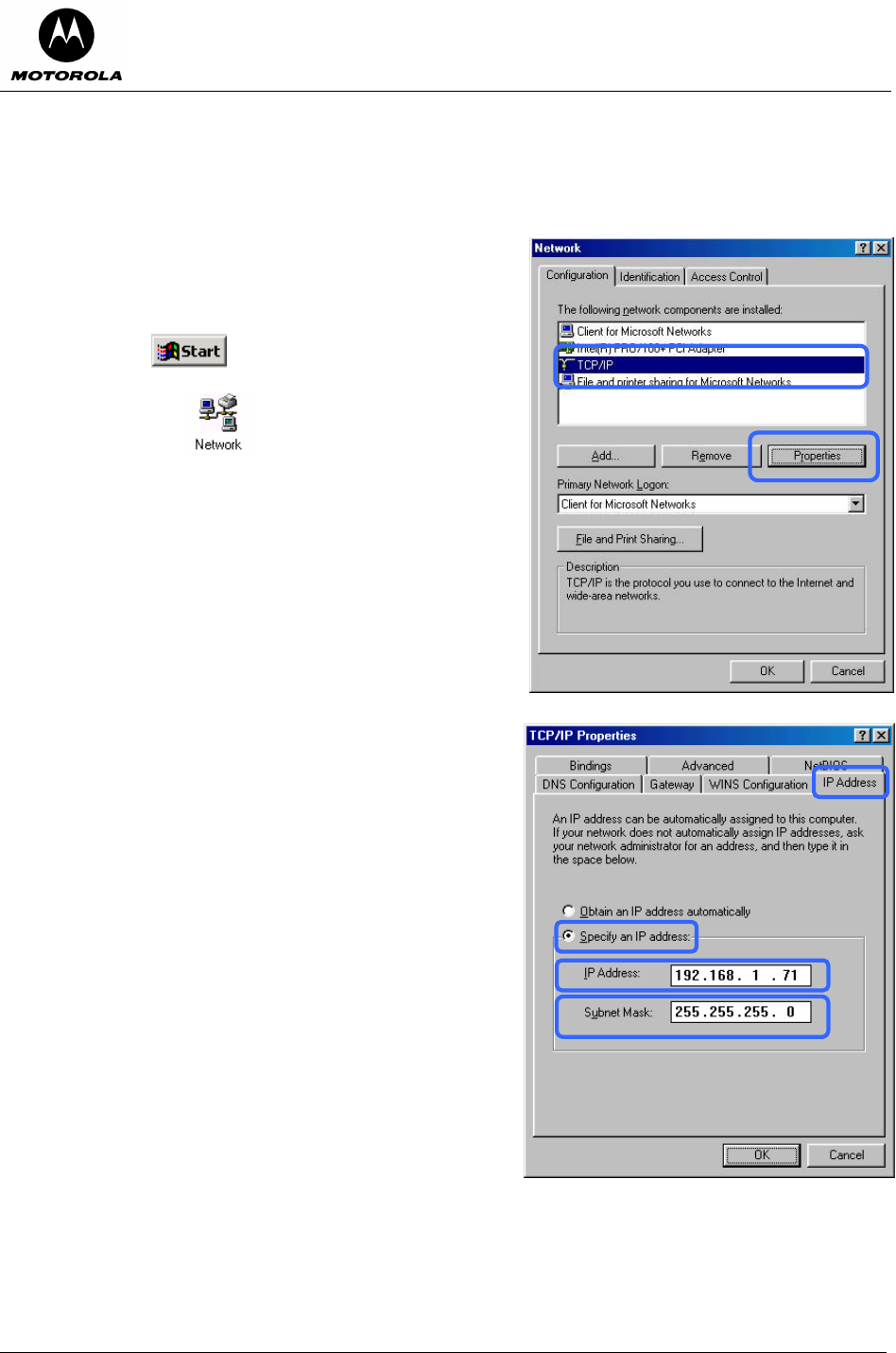
Motorola Cellular Gateway NC800 User Guide Version 2.0 Page 90 of 110
11. I need to set a static IP address on a PC.
The Motorola Cellular Gateway NC800 provides a DHCP server that automatically assigns IP numbers to PCs
on the network. Sometimes, you need to assign a specific IP address to a computer e.g. when you want to
configure a DMZ Host.
To assign a static IP address to a PC:
For Windows 98 and ME:
1. Click on the button. Select Settings->Control
Panel.
2. Double click on the icon.
3. In the Network dialog box, select the TCP/IP for the
applicable Ethernet adapter. Click on the Properties button.
4. Select the IP Address tab. Select Specify an IP address.
5. Choose an IP address that is in the same subnet as the
Motorola Cellular Gateway NC800. If you are using the
Motorola Cellular Gateway NC800’s default IP address of
192.168.1.1 then you have to choose an IP address in the
192.168.1.x range.
6. Type in a subnet mask. In most cases this will be
255.255.255.0.
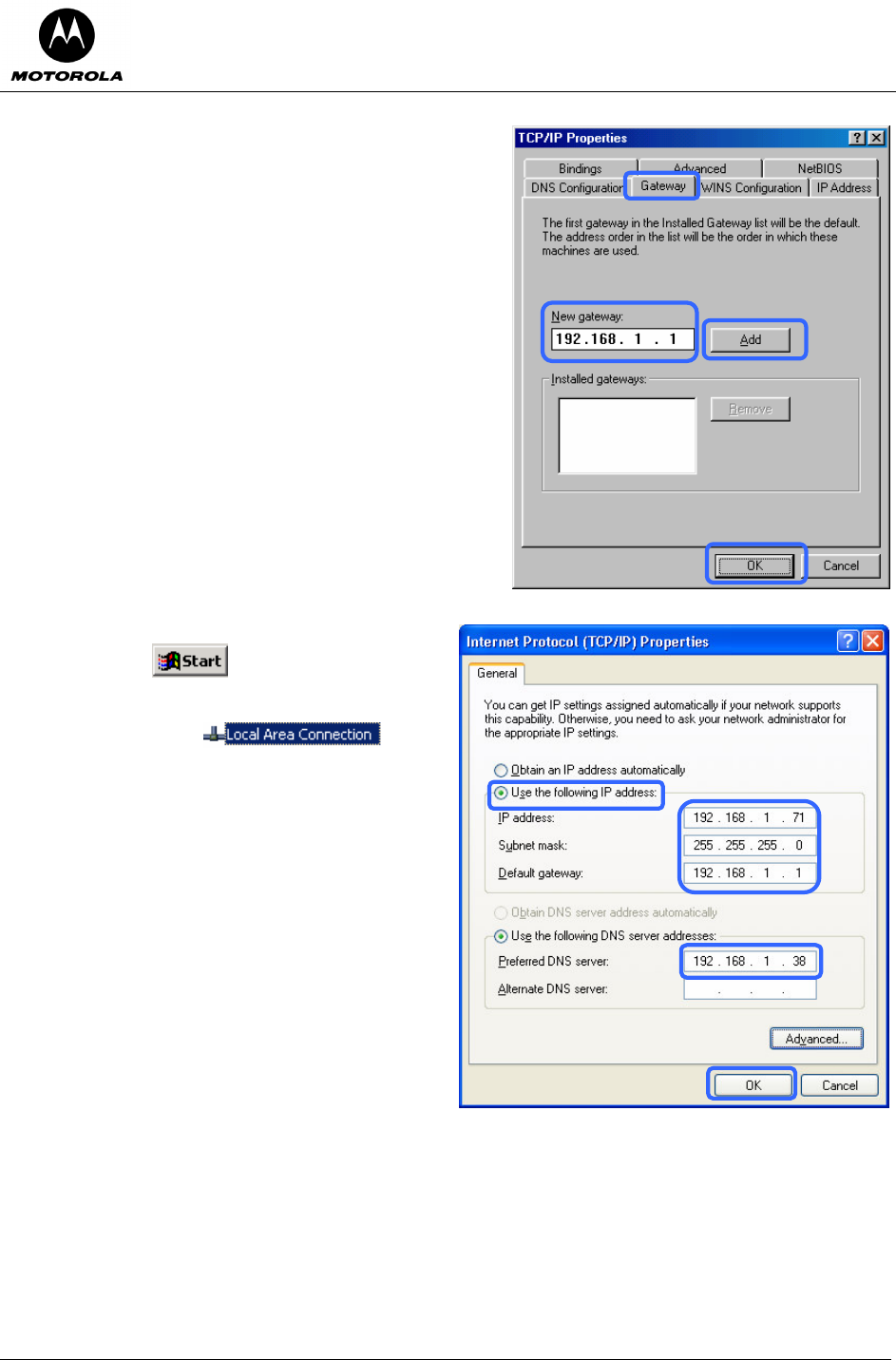
Motorola Cellular Gateway NC800 User Guide Version 2.0 Page 91 of 110
7. Click on the Gateway tab.
8. Type in the Motorola Cellular Gateway NC800’s IP
address in the New Gateway field and click on Add.
9. Click on OK to apply your changes and to close the dialog
box.
For Windows 2000 and XP:
1. Click on the button. Select Settings-
>Control Panel. Double click on Network and
Dial-up Connections.
2. Double click on the for the
applicable Ethernet adapter.
3. The Local Area Connection Status dialog box are
displayed:
4. Click on the Properties button.
5. Ensure that the check box next to Internet
Protocol (TCP/IP) is selected. Select Internet
Protocol (TCP/IP) and click on the Properties
button.
6. Select “Use the following IP address”. Type in a
unique IP address that is not used by any other
computer on the network.
7. Type in a subnet mask, e.g. 255.255.255.0.
8. Type in the Default Gateway for this computer. In
most cases this should be the IP address of the
Motorola Cellular Gateway NC800. If you are using
the Motorola Cellular Gateway NC800’s default IP
address this will be 192.168.1.1.
9. Select “Use the following DNS server
addresses”. Type in the IP addresses of the Preferred and Alternate DNS servers.
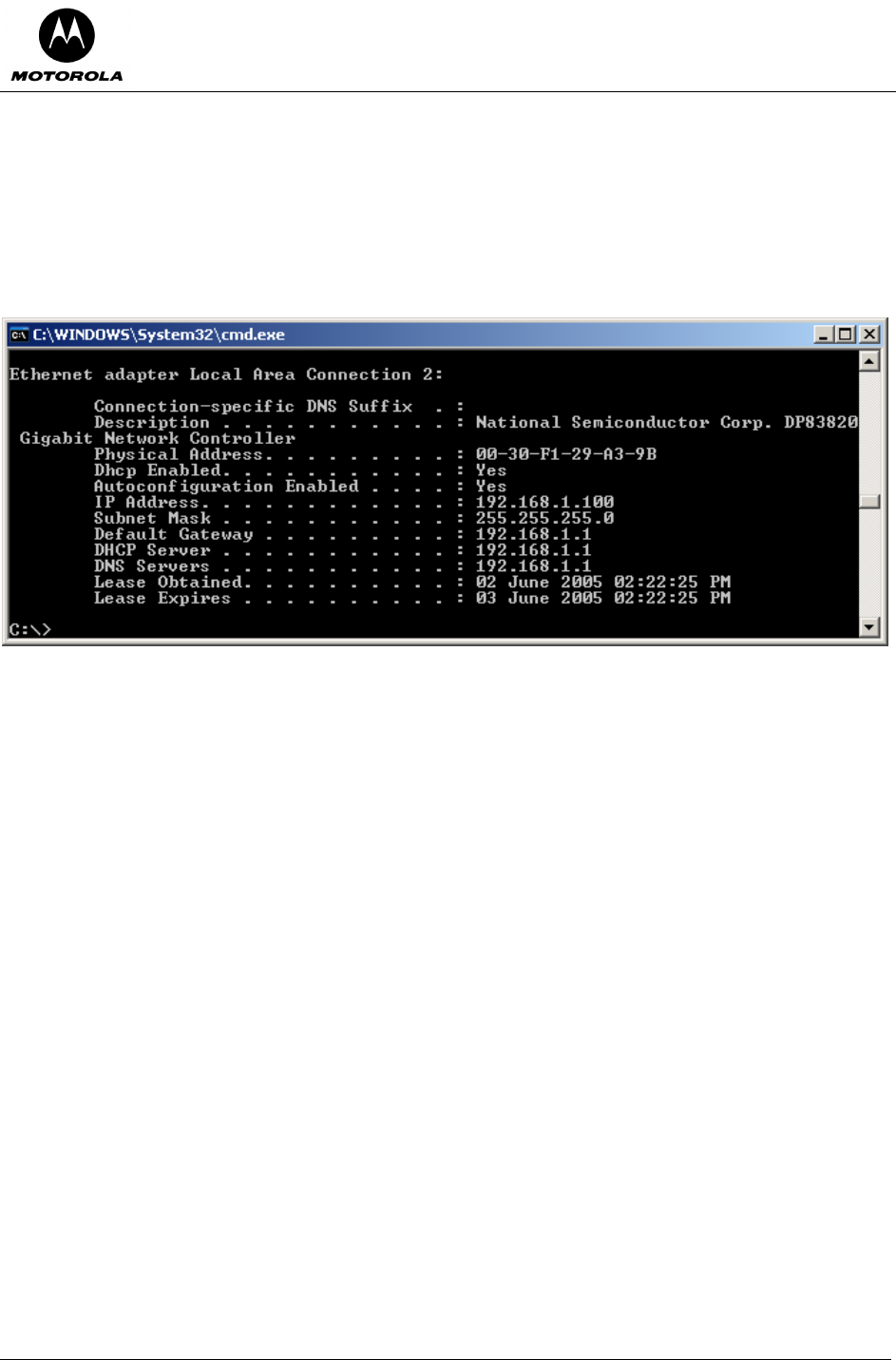
Motorola Cellular Gateway NC800 User Guide Version 2.0 Page 92 of 110
12. How do I determine a computer’s MAC address?
• Open a command console window (Go to Start -> Run. Type in cmd (if you are using Windows 98 / ME
type in command). When the console window opens, type in ipconfig /all.
• The following information will be displayed:
o IP address
o Subnet mask
o Default Gateway
o Host Name
o MAC Address (Physical Address)

Motorola Cellular Gateway NC800 User Guide Version 2.0 Page 93 of 110
Appendix C: Glossary
This section provides more background information on some of the terms and acronyms that are encountered
when dealing with wireless gateways.
10/100
Ethernet Card
A card that is installed in a computer to facilitate the connection to an Ethernet based LAN.
It will support up to 100 megabits per second of data transmitted over a UTP cable. This is
also called a Network Interface Card (NIC).
54g™ Broadcom’s 54 Mbps implementation of the draft specification for IEEE 802.11g wireless
networks. It is 802.11b-compliant and provides laptops, handheld computers and other
devices with wireless connectivity at nearly five times the speed of existing technologies
operating in the 2.4 GHz radio frequency range, while providing backwards compatibility to
the base of more than 30 million installed 802.11b devices.
A
AP A device that provides wireless LAN connectivity to wireless clients (stations). The Motorola
Cellular Gateway NC800 acts as a wireless access point.
Adapter A device or card that connects a computer, printer, or other peripheral device to the network
or to some other device. A wireless adapter connects a computer to the wireless LAN.
Address
translation
See NAT.
AH Authentication Header.
ALG Application level gateway triggers are required by some file transfer (for example, FTP),
game, and video conferencing applications to open one or more ports to enable the
application to operate properly.
ANSI The American National Standards Institute is a non-profit, independent organization
supported by trade organizations, industry, and professional societies for standards
development in the United States. This organization defined ASCII and represents the
United States to the International Organization for Standardization.
ARP Address Resolution Protocol broadcasts a datagram to obtain a response containing a MAC
address corresponding to the host IP address. When it is first connected to the network, a
client sends an ARP message. The Motorola Cellular Gateway NC800 responds with a
message containing its MAC address. Subsequently, data sent by the computer uses the
Motorola Cellular Gateway NC800 MAC address as its destination.
ASCII The American Standard Code for Information Interchange refers to alphanumeric data for
processing and communication compatibility among various devices; normally used for
asynchronous transmission.
authentication The process a station uses to announce its identity to another station. IEEE 802.11
specifies two forms of authentication: Open System and Shared Key.
Auto-MDIX Automatic medium-dependent interface crossover detects and corrects cabling errors by
automatically reversing the send and receive pins on any port. It enables the use of straight-
through wiring between the Motorola Cellular Gateway NC800 Ethernet ports and any
computer, printer, or hub.

Motorola Cellular Gateway NC800 User Guide Version 2.0 Page 94 of 110
AWG American Wire Gauge - A standard system used to designate the size of electrical
conductors; gauge numbers are inverse to size.
B
bandwidth The amount of data that can be transferred in a given amount of time. It is usually
measured in bits per second (bps).
beacon Small packets that are sent at regular intervals by a wireless gateway to synchronize the
wireless network.
binary A numbering system that uses two digits, 0 and 1.
Bit rate The number of bits (digital 0s and 1s) transmitted per second in a communications channel.
It is usually measured in bits per second bps.
bps Bits per second.
bridge An OSI layer 2 networking device that connects two LANs using similar protocols. It filters
frames based on the MAC address to reduce the amount of traffic. A bridge can be placed
between two groups of hosts that communicate frequently together, but not so much with
the hosts in the other group. The bridge examines the destination of each packet to
determine whether to transmit it to the other side. See also switch.
broadband High bandwidth network technology that multiplexes multiple, independent carriers to carry
voice, video, data, and other interactive services over a single cable. A communications
medium that can transmit a relatively large amount of data in a given time period.
broadcast Simultaneous transmission to multiple network devices; a protocol mechanism supporting
group and universal addressing. See also multicast and unicast.
C
CDMA Code Division Multiple Access.
Circuit-
switched
Network-connection scheme used in the traditional PSTN telephone network where each
connection requires a dedicated path for its duration. An alternative is packet-switched.
Class C
network
An IP network containing up to 253 hosts. Class C IP addresses are in the form
network.network.network.host.
client In a client/server architecture, a client is a computer that requests files or services such as
file transfer, remote login, or printing from the server. On an IEEE 802.11b wireless LAN, a
client is any host that can communicate with the access point. Also called a CPE. A
wireless client is also called a station.
CNR Carrier to Noise Ratio.
CPE Customer premise equipment, typically computers, printers, etc., are connected to the
gateway at the subscriber location. CPE can be provided by the subscriber or the service
provider. Also called a client.
Crossover
cable
A cable in which the receive and transmit lines (input and output) are crossed. Crossover
cables are often used to connect hubs together.
crosstalk Undesired signal interfering with the desired signal.

Motorola Cellular Gateway NC800 User Guide Version 2.0 Page 95 of 110
CSMA/CD Carrier Sense Multiple Access with Collision Detection.
D
datagram In RFC 1594, a datagram is defined as a self-contained, independent entity of data carrying
sufficient information to be routed from the source to the destination computer without
reliance on earlier exchanges between the source and destination computer and the
transporting network. For the most part, it has been replaced by the term packet.
Default
gateway
The gateway used to forward all traffic that is not addressed to a station within the local
subnet.
Default route The route by which packets are forwarded when other routes in the routing table do not
apply.
DHCP Dynamic Host Configuration Protocol - A protocol that lets network administrators manage
centrally and automate the assignment of Internet Protocol (IP) addresses in an
organization’s network. Each machine that can connect to the Internet needs a unique IP
address. When an organization sets up its computer users with a connection to the Internet,
an IP address must be assigned to each machine. Without DHCP, the IP address must be
entered manually at each computer and if computers move to another location in another
part of the network, a new IP address must be entered. DHCP lets a network administrator
supervise and distribute IP addresses from a central point and automatically sends a new
IP address when a computer is plugged into a different place in the network. DHCP uses
the concept of a “lease” or amount of time that a given IP address will be valid for a
computer. The lease time can vary depending on how long a user is likely to require the
Internet connection at a particular location. It’s especially useful in education and other
environments where users change frequently. Using very short leases, DHCP can
dynamically reconfigure networks in which there are more computers than there are
available IP addresses. DHCP supports static addresses for computers containing Web
servers that need a permanent IP address. DHCP enables the automatic reuse of unused
IP addresses. The Motorola Cellular Gateway NC800 contains a built-in DHCP server that
assigns private IP addresses to clients.
Directional
antenna
An antenna that concentrates transmission power into a direction, thereby increasing
coverage distance at the expense of coverage angle. Directional antenna types include
yagi, patch and parabolic dish.
Diversity
antennas
Two identical antennas located a small distance apart to reduce multipath distortion and
improve wireless reception. Properly placed diversity antennas improve Motorola Cellular
Gateway NC800 wireless reception.
DNS The Domain Name System is the Internet system for converting domain names to IP
addresses. A domain name is a meaningful and easy-to-remember “handle” for an Internet
address. A DNS server contains a table matching domain names such as
Internetname.com to IP addresses such as 192.169.9.1. When you access the world-wide
web, a DNS server translates the URL displayed on the browser to the destination website
IP address. The DNS lookup table is a distributed Internet database; no one DNS server
lists all domain name to IP address matches.
Domain name A unique name, such as motorola.com, that maps to an IP address. Domain names are
typically much easier to remember than are IP addresses.
Dotted-
decimal
notation
Method of representing an IP address or subnet mask using four decimal numbers called
octets. Each octet represents eight bits. In a class C IP address, the octets are
network.network.network.host. The first three octets together represent the network address
and the final octet is the host address. In the Motorola Cellular Gateway NC800 LAN default

Motorola Cellular Gateway NC800 User Guide Version 2.0 Page 96 of 110
configuration, 192.168.100 represents the network address. In the final octet, the host
address can be from 2 to 254. See IP Addresses.
download To copy a file from one computer to another. You can use the Internet to download files
from a server to a computer.
downstream In a CDMA network, the direction of data received by the computer from the Internet.
driver A software program that allows a computer to use and communicate with equipment or
peripherals installed on the computer. For example, network interface cards (NICs) require
drivers to allow the computer to communicate with the network through the NIC.
DSSS Direct Sequence Spread Spectrum is an IEEE 802.11b RF modulation protocol. It combines
a data signal at the sending station with a higher data rate bit sequence, which many refer
to as a chip sequence (also known as processing gain). A high processing gain increases
the signal's resistance to interference. The minimum processing gain that the FCC allows is
10, and most products operate under 20.
DTIM Delivery Traffic Indication Message.
Dynamic IP
address
An IP address that is automatically assigned to a client station in a TCP/IP network,
typically by a DHCP server. Network devices that serve multiple users, such as servers and
printers, are usually assigned static IP addresses.
E
encapsulate To include data into some other data unit to hide the format of the included data.
encode To alter an electronic signal so that only an authorized user can unscramble it to view the
information.
encrypt To encode data.
endpoint A VPN endpoint terminates the VPN at the gateway so that computers on the Motorola
Cellular Gateway NC800 LAN do not need VPN client software to tunnel through the
Internet to the VPN server.
ESP Encapsulating Security Payload.
Ethernet The most widely used LAN type, also known as IEEE 802.3. The most common Ethernet
networks are 10Base-T, which provide transmission speeds up to 10 Mbps, usually over
unshielded, twisted-pair wire terminated with RJ-45 connectors. Fast Ethernet (100Base-T)
provides speeds up to 100 Mbps. Base means baseband technology and T means twisted
pair cable. Each Ethernet port has a physical address called the MAC address.
Token Ring is another method to access a LAN, but not widely used. Ethernet can be used
on a shared network, where all clients share the bandwidth or on a switched network where
each sender and receiver pair has the full bandwidth. Ethernet uses a technology that
broadcasts each frame onto a medium such as wire or fiber. All computers, on the network,
are listening. The computer with the matching destination address accepts the frame and
checks for errors. Ethernet was invented in 1973 by Robert Metcalfe and David Boggs of
Xerox. It ran at 2.93 megabits per second (Mbps). Today Ethernet devices are available
that communicate at 1 gigabits per second (Gbps).
F
Fast Ethernet An Ethernet Network that will support up to 100 megabits per second of data transfer.

Motorola Cellular Gateway NC800 User Guide Version 2.0 Page 97 of 110
FCS Frame Check Sequence.
FHSS Frequency Hopping Spread Spectrum - Takes the data signal and modulates it with a
carrier signal that hops from frequency to frequency as a function of time over a wide band
of frequencies.
firewall A security software system on the Motorola Cellular Gateway NC800 that enforces an
access control policy between the Internet and the Motorola Cellular Gateway NC800 LAN.
A firewall determines which information passes in and out of a network.
firmware Code that is written onto programmable read-only memory (PROM) or more recently
FLASH memory. Once firmware has been written onto the PROM or FLASH memory, it is
retained even when the device is turned off.
frequency Number of times an electromagnetic signal repeats an identical cycle in a unit of time,
usually one second, measured in Hz, kHz, mHz, or GHz.
FTP File Transfer Protocol - A member of the TCP/IP suite of protocols, used to copy files
between two computers on the Internet. Both computers must support their respective FTP
roles: one must be an FTP client and the other an FTP server. See also TCP/IP.
Full duplex The ability to simultaneously transmit and receive data. See also half-duplex.
G
gateway A device that enables communication between networks using different protocols. The
Motorola Cellular Gateway NC800 enables multiple computers supporting IEEE 802.11b/g
and/or Ethernet to share a single Internet connection. A gateway is often included as part of
a network switch. A gateway can also be implemented as software on a computer.
GHz Gigahertz, which equals 1 billion cycles per second.
GUI Graphical User Interface.
H
Half duplex Network where only one device at a time can transmit data. See also full-duplex.
header The data at the beginning of a packet that identifies what is in the packet.
hexadecimal A base-sixteen numbering system that uses sixteen sequential numbers (0 to 9 and the
letters A to F) as base units before adding a new position. On computers, hexadecimal is a
convenient way to express binary numbers.
hub A hub offers a single collision domain among multiple wired users. When one user's
Ethernet NIC sends data, all other stations connected to the LAN will hold off sending data
until the medium is idle. A traditional wireless access point (AP) most closely resembles a
hub. A hub performs no data filtering. See also bridge and gateway.
hop The interval between two gateways on an IP network. The number of hops a packet
traverses toward its destination (called the hop count) is saved in the packet header. For
example, a hop count of six means the packet has traversed six gateways. The packet hop
count increases as the time-to-live (TTL) value decreases.
host In IP, a host is any computer supporting end-user applications or services with full two-way
network access. Each host has a unique host number that combined with the network
number forms its IP address. Host also can mean:

Motorola Cellular Gateway NC800 User Guide Version 2.0 Page 98 of 110
• A computer running a web server that serves pages for one or more web sites
belonging to organization(s) or individuals
• A company that provides this service
• In IBM environments, a mainframe computer
html Hyper Text Markup Language
http Hypertext Transfer Protocol - the standard computer programming language computers
linked to the World Wide Web use to communicate with each other.
Hz Hertz - one cycle per second. The unit to measure the frequency that an alternating
electromagnetic signal cycles through its highest and lowest states. Used to define the
bands of the electromagnetic spectrum used in voice and data communications, or to define
the bandwidth of a transmission medium.
I
IANA The Internet Numbering Address Authority (IANA) is an organization under the Internet
Architecture Board (IAB) of the Internet Society that oversees IP address allocation. It is
under a contract from the U.S. government.
IEEE The Institute of Electrical and Electronics Engineers. The IEEE describes itself as “the
world’s largest technical professional society, promoting the development and application of
electro technology and allied sciences for the benefit of humanity, the advancement of the
profession, and the well-being of our members.” The IEEE fosters the development of
standards that often become national and international standards. The organization
publishes a number of journals, has many local chapters, and several large societies in
special areas, such as the IEEE Computer Society. The IEEE (http://www.ieee.org) is
accredited by ANSI.
IEEE 802.3 See Ethernet.
IEEE 802.11b One of the IEEE standards for wireless networking hardware. Products that adhere to a
specific IEEE standard will work with each other, even if they are manufactured by different
companies. The 802.11b standard specifies a maximum data transfer rate of 11Mbps, an
operating frequency of 2.4GHz, and WEP encryption for security.
It uses Direct Sequence Spread Spectrum modulation in the unlicensed 2.4 GHz frequency
band also used by cordless phones and microwave ovens, therefore range and throughput
are affected by 2.4 GHz phones and microwave ovens operating in the vicinity. 802.11b
networks are also referred to as WLAN networks.
IEEE 802.11g Refers to the extension of the IEEE 802.11 standard for wireless networking. The 802.11g
specification used by the Motorola Cellular Gateway NC800 specifies a maximum data
transfer rate of 54Mbps using OFDM modulation, an operating frequency of 2.4GHz,
backward compatibility with IEEE 802.11b devices and WEP encryption as well as WPA-
PSK for security.
The higher speed comes from using Orthogonal Frequency Division Multiplexing (OFDM)
modulation. It is backwards compatible with 802.11b because it also uses the 2.4 GHz
frequency and is therefore also affected by 2.4 GHz phones and microwave ovens
operating in the vicinity.
IETF The Internet Engineering Task Force (http://www.ietf.org) is an open international
community of network designers, operators, vendors, and researchers to develop and
maintain Internet architecture. Technical working groups issue working documents called
Internet-Drafts. The IETF publishes review versions of the drafts called requests for
comments (RFCs).

Motorola Cellular Gateway NC800 User Guide Version 2.0 Page 99 of 110
Internet A worldwide collection of interconnected networks using TCP/IP.
internetwork A collection of interconnected networks allowing communication between all devices
connected to any network in the collection.
IP Internet Protocol is a set of standards that enable different types of computers to
communicate with one another and exchange data through the Internet. IP provides the
appearance of a single, seamless communication system and makes the Internet a virtual
network.
IP address In the most widely installed level of the Internet Protocol (IP) today, an IP address is a 32-
binary digit number that identifies each sender or receiver of information that is sent in
packets across the Internet. When you request an HTML page or send e-mail, the Internet
Protocol part of TCP/IP includes your IP address in the message (actually, in each of the
packets if more than one is required) and sends it to the IP address that is obtained by
looking up the domain name in the Uniform Resource Locator you requested or in the e-
mail address you're sending a note to. At the other end, the recipient can see the IP
address of the Web page requester or the e-mail sender and can respond by sending
another message using the IP address it received.
TCP/IP networks therefore route messages based on the destination IP address. An IP
address has two parts:
• The network address is assigned by IANA.
• A host address.
The Motorola Cellular Gateway NC800 network administrator assigns a host address to
each host connected to the Motorola Cellular Gateway NC800. This is done either via a
static IP address or automatically using its DHCP server. For a Class C network, the first 24
bits are the network address and the final 8 bits are the host address; in dotted-decimal
format it appears as network.network.network.host.
IPSec The Internet Protocol Security protocols are described in IETF authentication and
encryption standards for secure packet exchange over the Internet. IPSec consists of a
suite of protocols used to implement secure exchange of packets at the IP layer (i.e. OSI
layer 3). IPSec supports two basic modes: Transport and Tunnel. Transport encrypts the
payload of each packet, leaving the header untouched, while Tunnel mode encrypts both
the header and the payload and is therefore more secure.
ISM Bands
Industrial, scientific, and medicine bands - Radio frequency bands that the Federal
Communications Commission (FCC) authorized for wireless LANs. The ISM bands are
located at 902 MHz, 2.400 GHz, and 5.7 GHz.
ISO The International Organization for Standardization (http://www.iso.ch) is a worldwide
federation of national standards bodies from approximately 140 countries. ISO is a non-
governmental organization established in 1947 to promote the development of
standardization and related activities in the world with a view to facilitating the international
exchange of goods and services, and to developing cooperation in the spheres of
intellectual, scientific, technological, and economic activity.
ISP An ISP (Internet Service Provider) is a company that provides individuals and companies
access to the Internet and other related services such as Web site building and virtual
hosting. An ISP can serve IP addresses dynamically, or assign static (fixed) IP addresses to
individual computers.
ITU International Telecommunications Union
J
Javascript A scripting language designed by Netscape to enable Web designers to add dynamic

Motorola Cellular Gateway NC800 User Guide Version 2.0 Page 100 of 110
content to their sites. Contrary to its name, it was developed separately from Java. It is an
open source language.
K, L
LAN A LAN (Local Area Network) is a 2 – 1000 Mbps communications network that extends no
more than a few hundred meters, usually using Ethernet as the physical layer.
layer In networks, layers are software protocol levels. Each layer performs functions for the layers
above it. OSI is a reference model having seven functional layers.
LED Light Emitting Diode - Small lights that are typically used to indicate status on electronic
equipment. They come in almost any color with the most common being red, green, yellow
and recently, blue.
loopback A test that loops the transmit signal to the receive signal. Usually the loopback test is
initiated on a network device. The test is used to verify a path or to measure the quality of a
signal on that path.
M
MAC The Media Access Control address is a unique, 48-bit value permanently saved in ROM at
the factory to identify each Ethernet network device. It is expressed as a sequence of 12
hexadecimal digits. Also called an Ethernet address, physical address, hardware address,
or NIC address.
MB One megabyte; equals 1,024 x 1,024 bytes, 1,024 kilobytes, or about 8 million bits.
Mbps Million bits per second (megabits per second). A rate of data transfer.
media The various physical environments through which signals pass; for example, coaxial,
unshielded twisted-pair (UTP), or fiber-optic cable.
MHz Megahertz. One million cycles per second. A measure of radio frequency.
MRU The MRU (Maximum Receive Unit) sets the maximum number of bytes that PPP is capable
of receiving in one PPP packet. Generally, the bigger the better.
MTU The Maximum Transmission Unit is the largest amount of data that can be transmitted in
one discrete message on a given physical network. The MTU places an upper bound on the
size of a message that can be transferred by the network in a single frame. Messages
exceeding the MTU must be fragmented before transmission, and reassembled at the
destination.
multicast A data transmission sent from one sender to multiple receivers. See also broadcast and
unicast.
N
NAT Network Address Translation - An Internet standard that enables a local-area network
(LAN) to use one set of IP addresses for internal traffic and a second set of IP addresses
for external traffic. A NAT box located where the LAN meets the Internet makes all
necessary IP address translations. NAT provides some security
because the IP addresses of the LAN computers are invisible on the Internet.
NAPT Network Address Port Translation is the most common form of address translation between

Motorola Cellular Gateway NC800 User Guide Version 2.0 Page 101 of 110
public and private IP addresses. NAPT is a mapping of one public IP address to many
private IP addresses.
NEC National Electrical Code (United States) . The regulations for construction and installation of
electrical wiring and apparatus, suitable for mandatory application by a wide range of state
and local authorities.
network Two or more computers connected to communicate with each other. Networks have
traditionally been connected using some kind of wiring.
Network
driver
Software packaged with a NIC that enables the computer to communicate with the NIC.
Network layer Layer 3 in the OSI architecture that provides services to establish a path between open
systems. The network layer knows the address of the neighboring nodes, packages output
with the correct network address data, selects routes, and recognizes and forwards to the
transport layer incoming messages for local host domains.
NIC A network interface card converts computer data to serial data in a packet format that it
sends over the LAN. A NIC is installed in an expansion slot or can be built-in. Every
Ethernet NIC has a MAC address permanently saved in its ROM.
node On a LAN, a generic term for any network device.
Network mask See Subnet Mask.
O
Omni-
directional
antenna
An antenna that provides a 360-degree transmission pattern. These types of antennas are
used when coverage in all directions is required.
OFDM
Developed for wireless applications, Orthogonal Frequency Division Multiplexing
technology offers superior performance increased data rates and more reliable
transmissions than previous technologies, such as DSSS. OFDM is a scheme in which
numerous signals of different frequencies are combined to form a single signal for
transmission on the medium. OFDM works by breaking one high-speed data stream into a
number of lower speed data streams, which are then transmitted in parallel. Each lower
speed stream is used to modulate a sub carrier. Essentially, this creates a multi-carrier
transmission by dividing a wide frequency band or channel into a number of narrower
frequency bands or sub-channels. OFDM is also used for other applications, including
power line networking.
Open Systems
Authentication
The IEEE 802.11 default authentication method is a two-step process. First, the station
wanting to authenticate with another station sends an authentication management frame
containing the sending station's identity. The receiving station then sends back a frame
alerting whether it recognizes the identity of the authenticating station.
OSI The Open Systems Interconnection reference model is an illustrative model describing how
data moves from an application on the source host through a network to an application on
the destination host. It is a conceptual framework developed by ISO that is now the primary
model for intercomputer communications. OSI is a model only; it does not define a specific
networking interface.
P
packet The unit of data that is routed between the sender and destination on the Internet or other
packet-switched network. When data such as an e-mail message or other file is sent over
the Internet, IP on the sender divides the data into uniquely-numbered packets.The packet

Motorola Cellular Gateway NC800 User Guide Version 2.0 Page 102 of 110
header contains the source and destination IP addresses. The individual packets may travel
different routes. When all packets arrive at the destination, the IP at that end reassembles
the packets. The header and the data can vary in length. Packet and datagram are similar
in meaning.
Packet-
switched
A scheme to handle transmissions on a connectionless network such as the Internet. An
alternative is circuit-switched.
PCMCIA The Personal Computer Memory Card International Association sets international standards
for connecting peripherals to portable computers. Laptop computers typically have a
PCMCIA slot that can hold one or two PC Cards to provide features such as Ethernet
connectivity.
PDA Personal Digital Assistant
Physical layer Layer 1 in the OSI architecture. It provides services to transmit bits or groups of bits over a
transmission link between open systems. It entails the electrical, mechanical, and
handshaking procedures.
PING A network utility that tests host reachability by sending a small packet to the host and
waiting for a reply. If you PING a computer IP address and receive a reply, you know the
computer is reachable over the network. It also stands for Packet InterNet Groper.
port On a computer or other electronic device, a port is a socket or plug used to physically
connect it to the network or to other devices. In TCP/IP, a port is a number from 0 to 65536
used logically by a client program to specify a server program. Ports 0 to 1024 are reserved
POTS The plain old telephone service offered through the PSTN; basic analog telephone service.
POTS uses the lowest 4 kHz of bandwidth on twisted pair wiring.
PPP PPP (Point to Point Protocol) is a protocol for communication between computers using a
serial interface, typically a personal computer connected by phone line to a server.
PPPoE Point to Point Protocol over Ethernet.
PPTP Point-to-Point Tunneling Protocol encapsulates other protocols. It is a protocol that allows
corporations to extend their own corporate network through private “tunnels” over the public
Internet. Effectively, a corporation uses the wide-area network to create a large virtual
private network.
Private IP
address
An IP address assigned to a computer on the Motorola Cellular Gateway NC800 LAN by
the DHCP server on the Motorola Cellular Gateway NC800 for a specified lease time.
Private IP addresses are used by the Motorola Cellular Gateway NC800 LAN only; they are
invisible to devices on the Internet. See also public IP address.
protocol A formal set of rules and conventions for exchanging data. Different computer types (for
example PC, UNIX, or mainframe) can communicate if they support common protocols.
Proxy server A piece of software that sits between a client application (such as a Web browser) and the
Internet. It intercepts all traffic flowing between the two and analyzes them. This allows
proxy servers to do two important things. One is to boost Internet access speeds for groups
of users. Since the proxy server stores a "cache" of recently downloaded Web sites, any
user that tries to access a Web site that has recently been accessed by another user is
simply sent the cached version from the proxy server. The other important function is
filtering. A proxy server can be set up to filter all attempts by users to access specific Web
sites.
PSTN The public switched telephone network is the traditional circuit-switched, voice-oriented
telephone network. See also POTS.

Motorola Cellular Gateway NC800 User Guide Version 2.0 Page 103 of 110
Q, R
RFC Request for Comments published on the IETF or other websites. Many RFCs become
international standards.
RIP Routing Information Protocol - A common type of routing protocol. RIP bases its routing
path on the distance (number of hops) to the destination. RIP maintains optimum routing
paths by sending out routing update messages if the network topology changes. For
example, if a gateway finds that a particular link is faulty, it will update its routing table, and
then send a copy of the modified table to each of its neighbors.
RJ-11 The most common type of connector for household or office phones.
RJ-45 A connector for Cat 5 or Cat 5e cable, with 8 pins. It looks similar to a typical telephone wire
connector that only has 4 or 6 pins, but it is larger in size.
roaming A feature of some access points or gateways that allow users to move through a facility
while maintaining an unbroken connection to the LAN.
routing table A table listing available routes that is used by a gateway to determine the best route for a
packet.
RTS Request To Send.
S
scope The set of IP addresses that a DHCP server can lease to clients.
server A host computer that stores information and software programs used by other computers in
a network (it “serves” the programs and information to other computers). Examples of
services are file transfer, remote login and printing services.
Shared key
authentication
A type of authentication that assumes each station has received a secret shared key
through a secure channel independent from an 802.11 network. Stations authenticate
through shared knowledge of the secret key. Use of Shared Key authentication requires
implementation of the 802.11 Wireless Equivalent Privacy (WEP) algorithms.
SOHO Small Office Home Office
spectrum A specified range of frequencies used for transmission of electromagnetic signals.
spectrum
allocation
An allocation of portions of the available electromagnetic spectrum for specific services,
such as AM, FM, or personal communications.
SSID Service Set Identifier - An identification name that wireless devices use to make
connections. In order for wireless devices to communicate, they must all be set to the same
channel and they all must use the same SSID. For instance, if you are using an access
point to connect two computers using wireless devices, the access point and each of the
wireless devices must use the same SSID. Even if they are set to the same channel, they
cannot communicate unless the SSID is the same.
Stateful
inspection
A type of firewall that tracks each connection traversing all firewall interfaces to ensure
validity. In addition to examining the source and destination in the packet header based on
static rules, a stateful inspection firewall:
• Examines packet headers on context established by previous packets that
traversed the firewall
• Monitors the connection state and saves it in a table
• Closes ports until a connection to a specific port is requested
• May examine the packet contents up through the application layer to determine

Motorola Cellular Gateway NC800 User Guide Version 2.0 Page 104 of 110
more than just the source and destination
A stateful-inspection firewall is more advanced than a static filter firewall.
Static filter A type of firewall that examines the source and destination in the packet header based on
administrator-defined rules only.
Static IP
Address
A permanent IP address that is assigned to a host in a TCP/IP network. Normally, a static
IP address must be assigned manually. The opposite of dynamic IP address.
Static route A manually-defined route.
station IEEE 802.11b term for wireless client.
Subnet A network segment connected by hubs or repeaters. Subnets can stand alone or can be
connected to other subnetworks onto a larger network. When subnetting is used, the host
portion of the IP address is divided into a subnet and host number. Hosts and gateways use
the subnet mask to identify the bits used for the network and subnet number.
Subnet mask The method used for splitting IP networks into a series of subgroups, or subnets. The mask
is a binary pattern that is logically ANDed with the IP address to turn part of the host ID
address field into a field for subnets. A gateway routes packets using the network prefix and
the subnet number part of the IP address.
switch A switch is more sophisticated than a hub and connects one user to another without
blocking access of other users. The switch improves throughput because of the smaller
resulting collision domains. Users don't have to wait until others are finished before sending
data.
SYSLOG A de-facto UNIX standard for logging system events.
T
TCP Transmission Control Protocol - A method (protocol) used along with the IP (Internet
Protocol) to send data in the form of message units (datagram) between network devices
over a LAN or WAN. Transmission Control Protocol on OSI transport layer four, provides
reliable transport over the network for data transmitted using IP (network layer three). It is
an end-to-end protocol defining rules and procedures for data exchange between hosts on
top of connectionless IP. TCP uses a timer to track outstanding packets, checks errors in
incoming packets, and retransmits packets if requested.TCP is known as a "connection
oriented" protocol due to requiring the receiver of a packet to return an acknowledgment of
receipt to the sender of the packet resulting in transmission control.
TCP/IP Transmission Control Protocol/Internet Protocol - The basic communication language or set
of protocols for communications over a network (developed specifically for the Internet).
TCP/IP defines a suite or group of protocols and not only TCP and IP.
TFTP Trivial File Transfer Protocol is a scaled down version of the well known FTP protocol
commonly used for file transfer over the Internet. Being a scaled down protocol, it is ideal
for use in an embedded environment such as a wireless gateway. It is used to upload new
firmware to the Motorola Cellular Gateway NC800.
Transparent
bridging
A method to enable all hosts on the wired Ethernet LAN and IEEE 802.11b wireless LAN to
communicate as if they were all connected to the same physical network.
Transport
layer
Layer of the OSI concerned with protocols for error recognition and recovery. This layer
also regulates information flow.
TTL The time to live is the number of gateways (or hops) a packet can traverse before being

Motorola Cellular Gateway NC800 User Guide Version 2.0 Page 105 of 110
discarded. When a gateway processes a packet, it decreases the TTL by 1. When the TTL
reaches zero, the packet is discarded.
tunnel To place packets inside other packets to send over a network. The protocol of the enclosing
packet is understood by each endpoint, or tunnel interface, where the packet enters and
exits the network. VPNs rely on tunneling to create a secure network.Tunneling requires the
following protocol types:
• A carrier protocol, such as TCP, used by the network that the data travels over
• An encapsulating protocol, such as IPSec, L2F, L2TP, or PPTP, that is wrapped
around the original data
• A passenger protocol, such as IP, for the original data.
U
UDP User Datagram Protocol - A method (protocol) used along with the IP (Internet Protocol) to
send data in the form of message units (datagrams) between network devices over a LAN
or WAN. UDP is an OSI layer four protocol, while IP is a layer three protocol. UDP is known
as a “connection-less” protocol due to NOT requiring the receiver of a packet to return an
acknowledgment of receipt to the sender of the packet (as opposed to TCP).
unicast A point-to-point data transmission sent from one sender to one receiver. This the normal
way you access websites. See also broadcast and multicast.
URL Universal Resource Locator - URLs are the Internet equivalent of addresses. How do they
work? Like other types of addresses, they move from the general to the specific (from zip
code to recipient, so to speak). Take this URL, for example:
www.motorola.com/CellularGateway/index.html. First you have the protocol: http:/ then the
server address or domain: /www.motorola.com and finally the directory
:
/CellularGateway/ in which the file index.html resides.
USB Universal Serial Bus is a computer interface for add-on devices such as printers, scanners,
mice, modems, or keyboards. USB supports data transfer rates of 12 Mbps and plug-and-
play installation. You can connect up to 127 devices to a single USB port.
UTP Unshielded Twisted Pair. Also referred to as 10BASE-T or 100BASE-T network cable.
V
VLAN A virtual local area network is group of devices on different LAN segments that are logically
configured to communicate as if they are connected to the same wire.
VoIP Voice over Internet Protocol is a method to exchange voice, fax, and other information over
the Internet. Voice and fax have traditionally been carried over traditional telephone lines of
the PSTN using a dedicated circuit for each line. VoIP enables calls to travel as discrete
data packets on shared lines. VoIP is an important part of the convergence of computers,
telephones, and television into a single integrated information network.
VPN Virtual Private Network - Virtual Private Networks allows computers to use the public
Internet backbone as a channel for private data communication. With encryption and
encapsulation technology, a VPN creates a private passageway (tunnel) through the
Internet. VPNs allow remote offices, company road warriors, and even businesses'
customers to use the Internet, rather than pricey private lines, to reach company networks.
A VPN connection provides security and performance similar to a dedicated link (for
example, a leased line), but at much lower cost.

Motorola Cellular Gateway NC800 User Guide Version 2.0 Page 106 of 110
W
WAN Wide Area Network. A wide-area network provides a connection over a large geographic
area, such as a country or the whole world. The bandwidth depends on need and cost, but
is usually much lower than for a LAN.
WAP Wireless Access Point or Wireless Access Protocol. See also access point.
WECA Wireless Ethernet Compatibility Alliance - An alliance of companies throughout the world
that promote the use of the IEEE 802.11 standard in wireless technology. It is a trade
organization that works to ensure that all wireless IEEE 802.11b Wi-Fi devices such as
computer cards, laptops, air gateways, PDAs, etc. can communicate with each other.
WEP Wired Equivalent Privacy encryption protects the privacy of data transmitted over a wireless
LAN. WEP uses keys to encrypt and decrypt transmitted data. The access point must
authenticate a client before it can transfer data to another client. WEP is part of IEEE
802.11b. It is based on a 64- or 128- bit shared key algorithm, as described in the IEEE
802.11b standard.
WEP network
key
A network key is a key used for network encryption under the WEP algorithm. Under
802.11, a wireless station can be configured with up to four network keys, with the key
index values being 1, 2, 3, and 4. When an access point or a wireless station transmits an
encrypted message using a key that is stored in a specific key index, the transmitted
message indicates the key index that was used to encrypt the message body. The receiving
access point or wireless station can then retrieve the key that is stored at the key index and
use it to decode the encrypted message body.
Wi-Fi Wireless Fidelity - The IEEE 802.11 High Rate Standard used in wireless technology. The
Wi-Fi (pronounced y-phi) seal of approval assures the end customer of interoperability with
other network cards and access points which also bear the Wi-Fi logo. Wi-Fi is the brand
name applied to products supporting IEEE 802.11 or WLAN.
WINS Short for Windows Internet Naming Service, a system that determines the IP address
http://www.webopedia.com/TERM/W/IP_address.html associated with a particular network
computer. This is called name resolution. WINS supports network client and server
computers running Windows and can provide name resolution for other computers with
special arrangements. Determining the IP address for a computer is a complex process
when DHCP servers assign IP addresses dynamically. For example, it is possible for DHCP
to assign a different IP address to a client each time the machine logs on to the network.
WINS uses a distributed database that is automatically updated with the names of
computers currently available and the IP address assigned to each one. DNS is an
alternative system for name resolution suitable for network computers with fixed IP
addresses.
Wireless
network
interface
Couples the digital signal from the end-user appliance to the wireless medium, which is air.
WLAN Wireless Local Area Network - A group of computers and associated devices that
communicate with each other wirelessly. Wireless LANs are used increasingly in both home
and office environments.
WWW World Wide Web - The Internet's multimedia service containing countless areas of
information, documentation, entertainment, as well as business and personal home
pages. It is an interface to the Internet that you use to navigate and hyperlink to information.

Motorola Cellular Gateway NC800 User Guide Version 2.0 Page 107 of 110
Appendix D: Upgrading the Motorola Cellular Gateway NC800
firmware using TFTP
Trivial File Transfer Protocol (TFTP) is a scaled down version of the well-known FTP protocol commonly used
for file transfer over the Internet. Being a scaled down protocol, it is ideal for use in an embedded environment
such as a wireless gateway. It offers an alternative method of firmware upgrading to the web-based method.
The Motorola Cellular Gateway NC800 accepts TFTP file transfers only during the first three seconds after
boot up.
To upgrade the Motorola Cellular Gateway NC800’s firmware using TFTP follow these steps:
o Open a TFTP compatible client on a PC connected to the primary LAN of the Gateway. The PC must be
configured with a static IP address on the same subnet as the Gateway (The user must be able to
successfully ping the Gateway’s primary LAN IP address from the PC).
o Specify the Gateway’s Primary LAN IP address in the TFTP client.
o Specify binary mode for file transfer.
o Type PUT firmware.trx where firmware.trx is the full path to the new firmware file.
o Reset the Motorola Cellular Gateway NC800 by pressing the Reset button at the back of the Motorola
Cellular Gateway NC800.
o Hit the Enter button to issue the PUT firmware.trx command.
o The TFTP client reports the progress / result of the file transfer.
o If successful, the Motorola Cellular Gateway NC800 reboots using the new firmware image after
approximately 30 seconds (it first writes the new image to FLASH once it has been transferred).
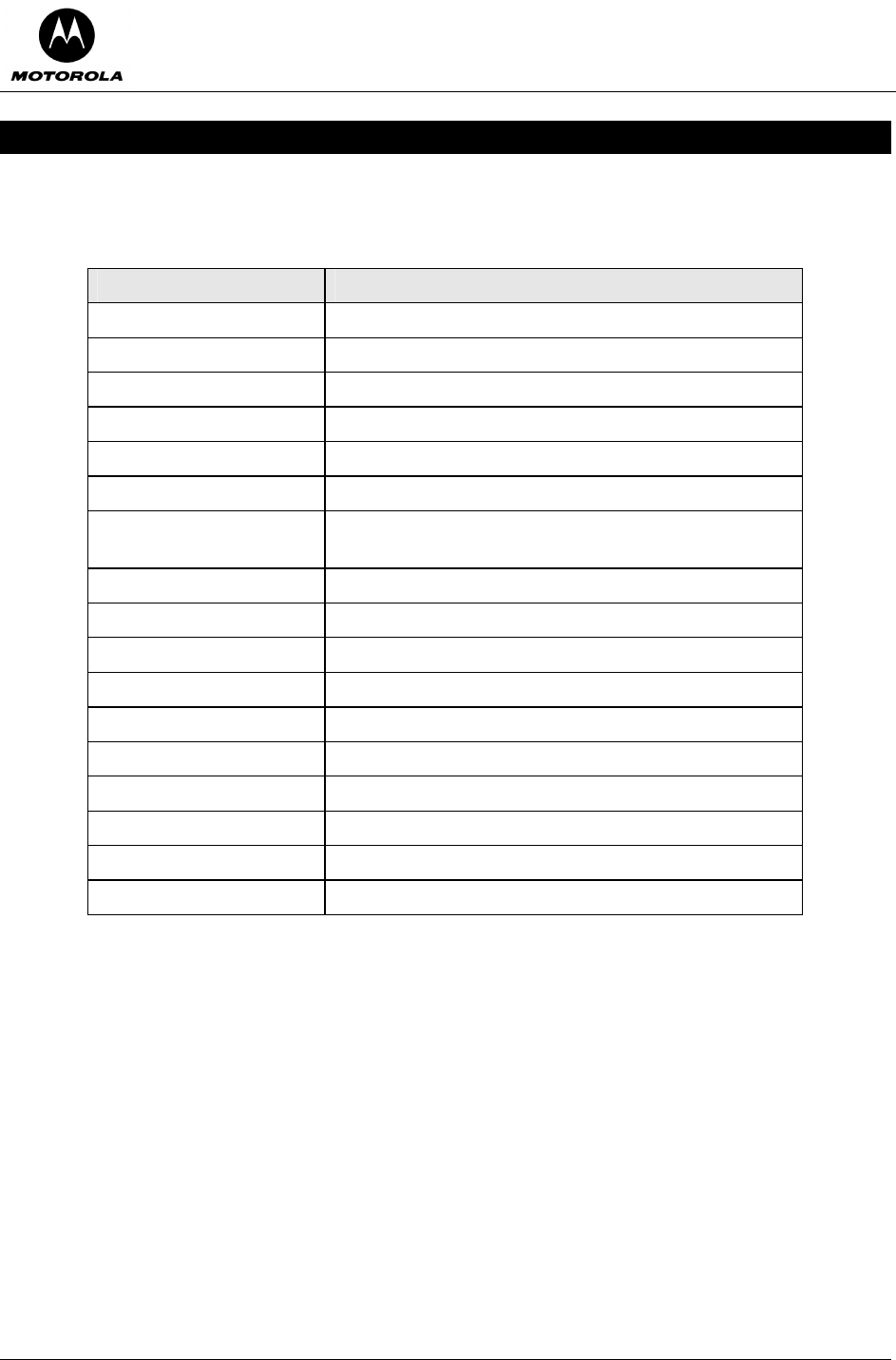
Motorola Cellular Gateway NC800 User Guide Version 2.0 Page 108 of 110
Appendix E: Technical Specifications
Standards
Standard Description
IEEE 802.3 Ethernet MAC interface
IEEE 802.1D MAC Bridging
IEEE 802.11b/g Wireless LAN
RFC 0768 User Datagram Protocol
RFC 0791 Internet Protocol
RFC 0793 Transmission Control Protocol
RFC 1035 DNS, Domain Names – Implementation and
Specification
RFC 1661 PPP
RFC 1812 IPv4 Routing
RFC 2131 DHCP
RFC 2453 RIP v2
RFC 2663 NAT/Masquerading
IS-95A CDMA Protocol between Mobile and Base Station
J-STD-008 PCS protocol between Mobile and Base station
TIA/EIA/IS-98-D CDMA2000 Mobile Devices Performance Standards
IS-707-A.5 CDMA Packet Data Service
FCC Class B Complies with Part 15 of the FCC Rules
Connectors
o Internet - One port for CDMA antenna
o LAN 1& 2 - Two 10/100 RJ-45 (UTP) Port
o Power - 12VDC, 1.8A (from included power brick)
o DIAG 1 - Debug port (for maintenance only)
o DIAG 2 - Debug port (for maintenance only)
Button
o One Reset Button
Network Management
o Web-based Configuration Interface
Cabling Type
o Category 5 Ethernet Network Cabling or better
WLAN Transmit Power

Motorola Cellular Gateway NC800 User Guide Version 2.0 Page 109 of 110
o 18 dBm
Modulation
o 802.11b: CCK, DQPSK, DBPSK (Direct Sequence Spread Spectrum)
o 802.11g: OFDM (Orthogonal Frequency Division Multiplexing)
WLAN Transmission Rates
o 802.11b 1, 2, 5.5, 11 Mbps
o 802.11g 6, 9, 12, 18, 24, 36, 48, 54 Mbps
WLAN Antenna Type
o 2 dBi dipole antenna with diversity
CDMA Antenna
o Dimensions (170mm L x 20mm B x 15mm D)
CDMA
o Dual Band 800/1900 MHz
o CDMA 1xRTT / EV-DO
WLAN Frequency Range
o 2.4 – 2.4835 GHz (ISM Band)
Wireless Range
o Indoors 100 meters
o Outdoors 300 meters
LED Indicators
o Power
o WLAN Act, Link
o LAN 1 Act, Full, 100
o LAN 2 Act, Full, 100
o WAN Link, Act, Signal
Environmental
o Dimensions (240mm L x 160mm W x 70mm H)
o Unit Weight Approx. 450g (1 lb)
o Certifications FCC Class B, CE Mark
o Operating Temp. 0°C to 40°C (32°F to 104°F)
o Storage Temp. -20°C to 70°C (-4°F to 158°F)
o Operating Humidity 10% to 85%, Non-Condensing
o Storage Humidity 5% to 90%, Non-Condensing
External power - Provided by an AC adapter
o Input: 100-250Volts AC, 47-63Hz, 0.4Amps
o Output: 12V DC, 1.8A

Motorola Cellular Gateway NC800 User Guide Version 2.0 Page 110 of 110
Software License
Motorola, Inc., Broadband Communications Sector (Motorola), 101 Tournament Drive, Horsham, PA 19044
IMPORTANT: PLEASE READ THIS SOFTWARE LICENSE CAREFULLY BEFORE YOU INSTALL,
DOWNLOAD OR USE ANY APPLICATION SOFTWARE, USB DRIVER SOFTWARE, FIRMWARE AND RELATED
DOCUMENTATION (SOFTWARE) PROVIDED WITH MOTOROLA’S CELLULAR GATEWAY NC800 PRODUCT (THE
MOTOROLA CELLULAR GATEWAY NC800 PRODUCT). BY USING THE MOTOROLA CELLULAR GATEWAY NC800 PRODUCT
AND/OR INSTALLING, DOWNLOADING OR USING ANY OF THE SOFTWARE, YOU INDICATE YOUR ACCEPTANCE OF EACH
OF THE TERMS OF THIS LICENSE. UPON
ACCEPTANCE, THIS LICENSE WILL BE A LEGALLY BINDING AGREEMENT BETWEEN YOU AND MOTOROLA.
THE TERMS OF THIS LICENSE APPLY TO YOU AND TO ANY SUBSEQUENT USER OF THIS SOFTWARE.
IF YOU DO NOT AGREE TO ALL OF THE TERMS OF THIS LICENSE (I) DO NOT INSTALL OR USE THE SOFTWARE
AND (II) RETURN THE MOTOROLA CELLULAR GATEWAY NC800 PRODUCT AND THE SOFTWARE (COLLECTIVELY,
PRODUCT), INCLUDING ALL COMPONENTS, DOCUMENTATION AND ANY OTHER MATERIALS PROVIDED WITH THE
PRODUCT, TO YOUR POINT OF PURCHASE OR SERVICE PROVIDER, AS THE CASE MAY BE, FOR A FULL REFUND.
The Software includes associated media, any printed materials, and any on-line or electronic documentation, as well as
any updates, revisions, bug fixes, or drives obtained by you from Motorola or your service provider. Software provided by
third parties may be subject to separate end-user license agreements from the manufacturers of such Software.
The Software is never sold. Motorola licenses the Software to the original customer and to any subsequent licensee for
personal use only on the terms of this License. Motorola and its 3rd party licensors retain the ownership of the Software.
You may:
USE the Software only in connection with the operation of the Product.
TRANSFER the Software (including all component parts and printed materials) permanently to another person, but only if
the person agrees to accept all of the terms of this License. If you transfer the Software, you must at the same time transfer
the Product and all copies of the Software (if applicable) to the same person or destroy any copies not transferred.
TERMINATE this License by destroying the original and all copies of the Software (if applicable) in whatever form.
You may not:
(1) Loan, distribute, rent, lease, give, sublicense or otherwise transfer the Software, in whole or in part, to any other person,
except as permitted under the TRANSFER paragraph above. (2) Copy or translate the User Guide included with the
Software, other than for personal use. (3) Copy, alter, translate, decompile, disassemble or reverse engineer the Software,
including but not limited to, modifying the Software to make it operate on non-compatible hardware. (4) Remove, alter or
cause not to be displayed, any copyright notices or startup message contained in the Software programs or
documentation. (5) Export the Software or the Product components in violation of any United States export laws.
The Product is not designed or intended for use in on-line control of aircraft, air traffic, aircraft navigation or aircraft
communications; or in design, construction, operation or maintenance of any nuclear facility. MOTOROLA AND ITS 3RD
PARTY LICENSORS DISCLAIM ANY EXPRESS OR IMPLIED WARRANTY OF FITNESS FOR SUCH USES. YOU
REPRESENT AND WARRANT THAT YOU SHALL NOT USE THE PRODUCT FOR SUCH PURPOSES.
Title to this Software, including the ownership of all copyrights, mask work rights, patents, trademarks and all other
intellectual property rights subsisting in the foregoing, and all adaptations to and modifications of the foregoing shall at all
times remain with Motorola and its 3rd party licensors. Motorola retains all rights not expressly licensed under this
License. The Software, including any images, graphics, photographs, animation, video, audio, music and text
incorporated therein is owned by Motorola or its 3rd party licensors and is protected by United States copyright laws and
international treaty provisions. Except as otherwise expressly provided in this License, the copying, reproduction, distribution
or preparation of derivative works of the Software, any portion of the Product or the documentation is strictly prohibited
by such laws and treaty provisions. Nothing in this License constitutes a waiver of Motorola’s rights under United States
copyright law.
This License and your rights regarding any matter it addresses are governed by the laws of the Commonwealth of
Pennsylvania, without reference to conflict of laws principles. THIS LICENSE SHALL TERMINATE AUTOMATICALLY if
you fail to comply with the terms of this License.
Motorola is not responsible for any third party software provided as a bundled application, or otherwise, with the
Software.
U.S. GOVERNMENT RESTRICTED RIGHTS
The Product and documentation is provided with RESTRICTED RIGHTS. The use, duplication or disclosure by the
Government is subject to restrictions as set forth in subdivision (c)(1)(ii) of The Rights in Technical Data and Computer
Software clause at 52.227-7013. The contractor/manufacturer is Motorola, Inc., Global Telecom Solutions Sector, 1475
W. Shure Drive, Arlington Heights, IL 60004.